American Bonsai at the NC Arboretum
+95
kingsnake
Tom
MKBonsai
BrianS
manumidam
Chris Cochrane
Intricate Simplicity
chench53
KyleT
Maros Belan
DjTommy
Bolero
Gonetopot
Rick36
M. Frary
Van
Toshiro
fiona
Precarious
drbuzzbee
geo
LanceMac10
MichaelS
kimo
Chellis
Leo Schordje
FrankP999
dick benbow
BrianG
crust
TN Jim
Seth Ellwood
Wander
peterkang
Judgie
Kevin S - Wisco Bonsai
Vance Wood
JMcCoy
brett2013
GerhardGerber
lordy
Eric Group
my nellie
steveb
Jaybird
Todd Ellis
jgeanangel
Daygan
AlainK
Richard S
Randy_Davis
Robert J. Baran
David Brunner
William N. Valavanis
Jkd2572
Dale Cochoy
Jesse McMahon
prestontolbert
yamasuri
bingregory
Stephen Krall
DougB
Ashiod
JADunnagan
sayotefries
JudyB
Dan W.
Khaimraj Seepersad
DuncanJH
Dave Murphy
monte
MikeG
augustine
Russell Coker
Kev Bailey
lennard
BigDave
Marty Weiser
Smithy
coh
tmmason10
dorothy7774
gman
Dave Leppo
hometeamrocker
bwaynef
Billy M. Rhodes
Walter Pall
Sam Ogranaja
JimLewis
MartinSweeney
bonsaisr
Auballagh
John Quinn
Arthur Joura
99 posters
Page 9 of 40
Page 9 of 40 •  1 ... 6 ... 8, 9, 10 ... 24 ... 40
1 ... 6 ... 8, 9, 10 ... 24 ... 40 
 Considering the Painted Tree Images, part 5: Conclusions
Considering the Painted Tree Images, part 5: Conclusions
Thank you Jim, Daygan, Khaimraj, Walter and Jun, for participating in the discussion!
When I first thought to post some images of trees depicted in painted artworks I had no idea that it would develop into the sprawling, time consuming project it has. I have no regrets about it, because the exercise has been an enjoyable one for me, and reviewing the selected images in some detail allowed me to share with you ideas that are of importance to me in my own view of bonsai. This topic also prompted many responses from others, and it has been interesting to me to learn how differently people can respond to the same stimuli. The time has come, however, to wrap up and move on. Soon spring will be upon us once again and the plants will demand their due, and that will leave less time for sitting at the computer writing about highfalutin concepts.
My motivation at the start was pretty simple - I was looking at paintings in a museum and began studying those that contained representations of trees, just wanting to observe how these accomplished artists went about their business. I was not, and am not, interested in copying in bonsai form the trees they depicted in the medium of paint. That can certainly be done, as Randy Davis ably demonstrated with his Pierneef tree. The image recently posted by Jun of his tray landscape planting with the ficus tree atop a piece of stone, evoking the general feeling of Chinese landscape painting, is another example of a way to go in this vein. There is absolutely nothing wrong with doing such if the idea appeals to you, but it does not appeal to me. In fact, moving ever further away from copying other people's representations of trees is one of my prime objectives.
Nor was I ultimately all that interested in how these various artists handled their medium or what might be the relative value of their work in terms of artistic merit. The paintings I started out looking at in person were all hanging in a great art museum, and the images I later found on Wikimedia were mostly all from other museums around the world, so my assumption is that they all have some substantial level of artistic merit. Khaimraj, apparently being an academically trained, professional artist, posted repeatedly his strong feelings about ART. I respect his knowledgeable opinions, but I do not concern myself with ART. Likewise, although I have more than a little interest in painting, the concerns of that medium are unimportant to me in my bonsai work. This is a bonsai forum. Although some people might have thought I was straying off-topic, my purpose on this forum is strictly about bonsai, and not painting or anything else.
In looking at the painted images of trees, I was first and foremost trying to discern what the various artists knew... about trees.
Was their knowledge about trees first-hand? Was it intimate? In their work, did they reveal that they had spent considerable time studying trees in nature, and had come to know some basic truths about them? Or were trees only a peripheral concern in their imagery, the stuff of background scenery or perhaps another item to be described with a shorthand symbol in order to tell a story or convey an idea? Several times I used the term "tree-ness" and that was my intended meaning - to what degree actual, observed information about trees was contained in the artist's rendition of that subject.
What does this image tell me about trees?
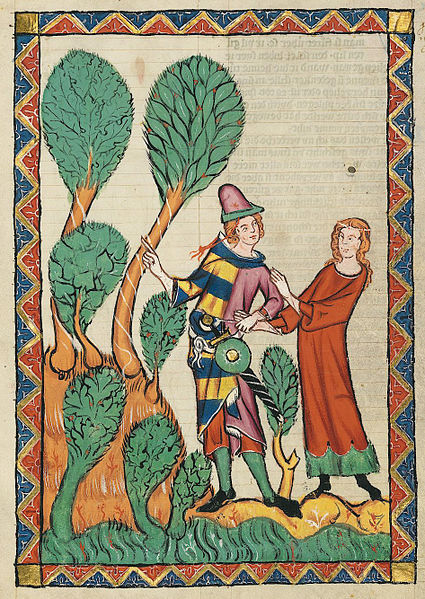
Unknown, early 14th century, German
What does this image tell me about trees?
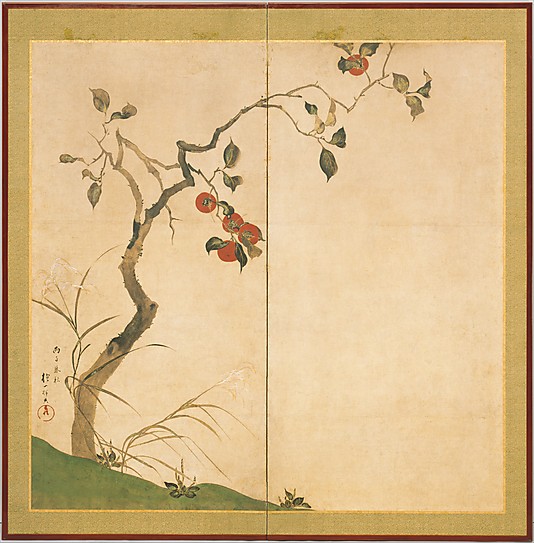
Sakai Hoitsu, 1816, Japanese (www.metmuseum.org)
What does this image tell me about trees?
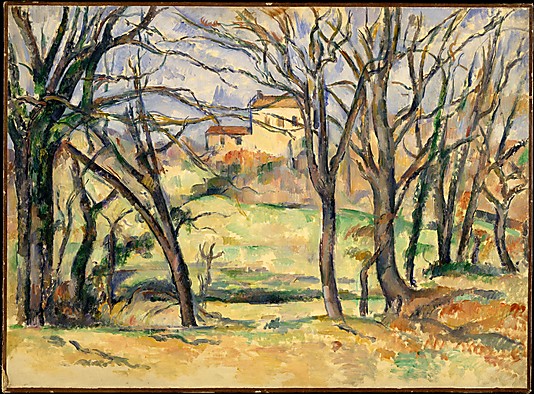
Paul Cezanne, 1886, French (www.metmuseum.org)
Trees, in case you have not noticed, are of tremendous personal interest and importance to me. This fact has surfaced repeatedly in my past posts on this thread, and I expect it will continue that way for as long as this thread continues, so I will not belabor the point here. I will, however, say this, and I do not think I have stated it so directly in this forum before - my primary interest in bonsai is as a vehicle for conveying my love of trees.
Like virtually everyone else in western bonsai, I started out by following the Japanese example. My earliest teachers were either Japanese - Yuji Yoshimura, Susumu Nakamura - or westerners who held closely to Japanese ideals - Bob Drechsler, Bill Valavanis, Chase Rosade, Peter Adams. I learned a lot from books and magazines as well, but these too were almost always espousing the Japanese way of bonsai or some derivative version of it. It took some time for me to recognize that there was a disconnect between trees as I knew them from my own firsthand experience and trees as they were represented in bonsai. I began to wonder why this disconnect exists.
One obvious reason is simply because bonsai trees and trees as they exist in nature are 2 different things. Just as a painted image of a tree is not actually a tree but dabs of paint applied to a surface of some material, a bonsai is not actually a tree in the common sense of the word. This can be confusing because most often we do use an actual tree as our medium, but we also sometimes use shrubs and vines, and our little "trees" are always cultivated out of the ground, whereas trees in nature have their roots anchored in the earth. More importantly, the plants we use for bonsai are always heavily manipulated, and not allowed to develop entirely as dictated by the inclination of their species and the conditions of their environment. In short, trees in nature are shaped primarily by natural forces, whereas bonsai are shaped primarily through the agency of human control.
Another elemental difference between bonsai trees and trees in nature pertains to the dramatic contrast in size. Trees in nature, even the smaller species, are typically all larger when fully grown than even an exceptionally big bonsai. This fact creates difficulty in having a bonsai look like a tree in nature because there are distortions arising from the impossibility of keeping all the essential parts in scale. But as everyone in bonsai knows, or should know, bonsai is an artistic representation of a tree - an interpretation - not a scale model. By the way, when I saw the picture posted by Walter there was very little doubt in my mind that the drawing was made of a bonsai and not of a tree in nature:

What makes me think so are the distortions of scale inherent in bonsai representations of trees. (Going further out on the metaphorical limb, I will hazard to guess that this drawing used one of Walter's bonsai as its model!)
But the disconnect of which I was becoming uncomfortably aware was the result of something else. Even allowing for the differences between any subject and a representation of it in an artistic medium, or the distortion inherent in a small representation of a larger object when it is impossible to keep to scale, there was something in the look of bonsai that did not ring true to my own conception of how trees are built. It took me a long time to figure it out (I am not the brightest bulb in the knife drawer!) but the answer finally came down to this - fashion.
Fashion. Or, more precisely, fashion dictated by the conventions of a particular cultural aesthetic. The great majority of bonsai do not look like trees in nature because trees as they grow in nature are not the model for most bonsai. The prevailing model for western bonsai is Japanese bonsai, which itself was modeled on what was originally a Chinese interpretation of nature. The degree of separation here is enormous. China and Japan are both ancient cultures, with China being the older and richer of the two. Consider again this image:
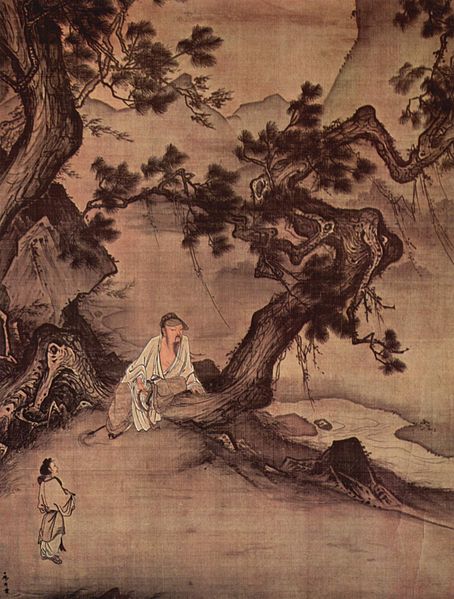
Ma Lin, 1246, Chinese
Now consider that this image was created more than 100 years after the more than 200 year period that is considered to be the "Great Age" of Chinese landscape painting! Even in the time of Ma Lin, Chinese art was highly conscious of its own tradition, and great value was placed on the continuity of that tradition. So Ma Lin may well have been observing the natural example, but he was almost certainly observing it through the lens of already well established Chinese conventions of artistic representation... in 1246!
From China this same tradition is imported by Japan, and after several centuries is modified to become the Japanese tradition. Long after the traditions informing the art of painting are in place, penjing and then bonsai eventually appear, and these newer art forms are directly influenced by the older, more established one. Remember the "Mustard Seed Garden Manual of Painting"? That book contained instruction on the accepted conventions of landscape painting and those same examples were then applied to bonsai. So even early on, the people who were shaping bonsai were more influenced by established ways of representing nature in art than they were by the study of nature itself. Those who came along later looked for their bonsai inspiration to the example of those who came before them. Bonsai in Japan over time has become, in my opinion, a reflection of itself. Fast forward to the 20th century, and we find bonsai being introduced by the Japanese to the people of the western cultures. They teach the art as they know it, and the new initiates in the west learn as all novice students learn, by imitating the teacher. Our teachers were not very concerned with the natural example, so we were not, either.
The great majority of bonsai in the west do not look like trees in nature because people in the west are largely stuck on imitating an example given to them by a culture foreign to their own. It is not that the medium of bonsai is not flexible enough to accept other possibilities, but rather that the minds of most western bonsai practitioners have not yet been flexible enough to explore the possibilities.
************************************************************************************************************************************************************
I stop now and look back on all that I have written in this post, and I realize - I am swimming in the middle of a great ocean, far from land, and there is no one else around me. I could go on and on this way but there is no reason to do so, right here and right now.
Before I conclude, however, I must reference the picture posted by Jim:
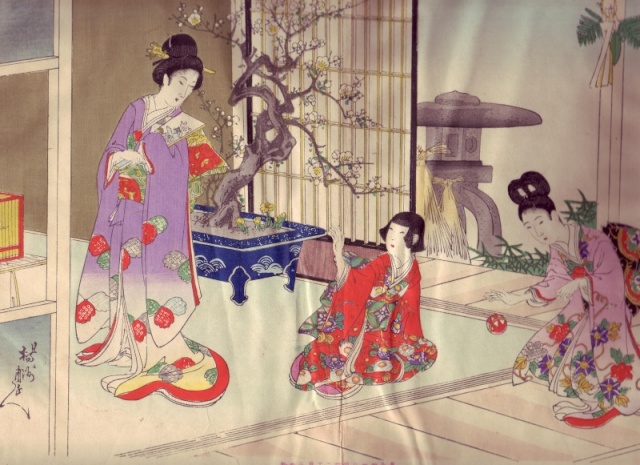
This is a woodblock print, a "ukiyoe" in Japanese, and Khaimraj declared it "incredibly beautiful". I expect that most of the people who read this forum would agree with Khaimraj, and I would guess that a good many already knew the correct Japanese term for a woodblock print. I have familiarity with such images, dating back to long before I had any interest in bonsai, when my primary study was in various forms of pictorial art. I liked some Japanese woodblock prints quite a bit and cared less for others. Even back when I enjoyed them, I do not think this particular one would have appealed to me, but that is strictly a matter of personal taste.
Now, however, my honest reaction to this image is one of sadness. I see it and I think, well there it is - the full-blown cliché. I hear the strains of traditional Asian music, the kind they play in Chinese and Japanese restaurants. I hear again the words I have heard repeatedly over the years, jokingly called out by my co-workers or by visitors at the bonsai garden, spoken in a phony, stereotypical Asian accent: "Ooooh, ah-so! The ancient art of banzai!"
It is bonsai stuck within the bubble of Asian-identification, like a prehistoric bug trapped in amber:
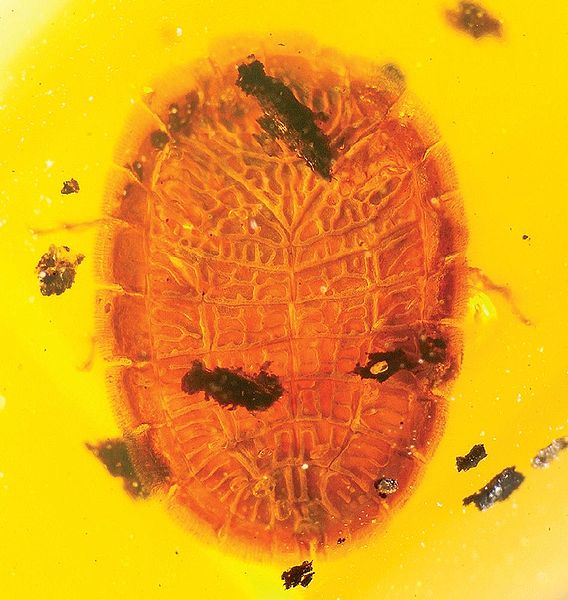
I know saying such things will upset some people on this site, and to them I sincerely apologize. I respect, and have nothing at all against, the wonderful culture of the Far East. For those of you who revel in it, be assured that most everything else you will see and read on this site, and on any other bonsai web site, or in virtually any bonsai book or magazine, will confirm the image of bonsai that is comforting and familiar to you. Go in peace.
For anyone else out there who thinks differently, who might be drawn to bonsai primarily as a vehicle for expressing an admiration of nature in general, and trees in particular, and who might find an image like this:
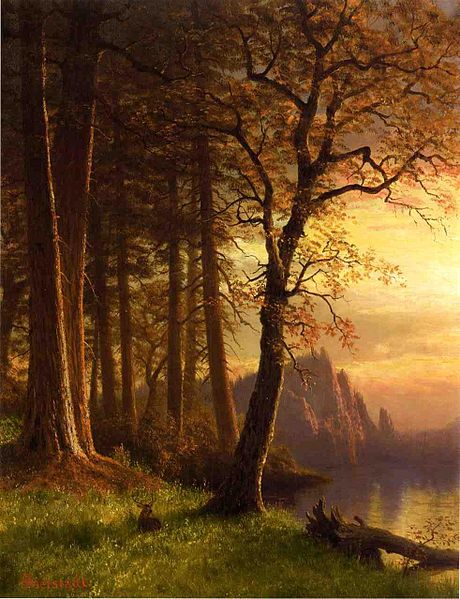
to be more culturally appealing than an image like this:
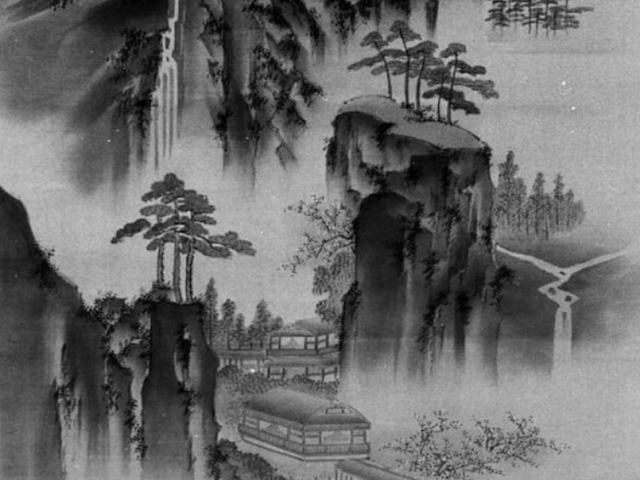
(www.metmuseum.org)
know that you are not alone. And be encouraged by the good news that it is possible to do bonsai without reference to a foreign culture, and that the results can be legitimate and beautiful.
I will finish this entry with a quote from Daygan, our American friend living in China, who drops by here only occasionally to leave a thoughtful and intelligent observation:
"...in the same way that the styles of paintings differ from region to region, era to era, and individual to individual, so also do the styles that the artists use for depicting trees. I wonder if some of us who do bonsai might consider this fluidity of artistic style to be something that translates to our medium as well? If trees can be depicted on canvas in various ways by various individuals across the ages, can we, in our attempts at artistry, not choose styles in an equally varied range according to our tastes and preferences?"
Thank you, Daygan. The answer is YES.
When I first thought to post some images of trees depicted in painted artworks I had no idea that it would develop into the sprawling, time consuming project it has. I have no regrets about it, because the exercise has been an enjoyable one for me, and reviewing the selected images in some detail allowed me to share with you ideas that are of importance to me in my own view of bonsai. This topic also prompted many responses from others, and it has been interesting to me to learn how differently people can respond to the same stimuli. The time has come, however, to wrap up and move on. Soon spring will be upon us once again and the plants will demand their due, and that will leave less time for sitting at the computer writing about highfalutin concepts.
My motivation at the start was pretty simple - I was looking at paintings in a museum and began studying those that contained representations of trees, just wanting to observe how these accomplished artists went about their business. I was not, and am not, interested in copying in bonsai form the trees they depicted in the medium of paint. That can certainly be done, as Randy Davis ably demonstrated with his Pierneef tree. The image recently posted by Jun of his tray landscape planting with the ficus tree atop a piece of stone, evoking the general feeling of Chinese landscape painting, is another example of a way to go in this vein. There is absolutely nothing wrong with doing such if the idea appeals to you, but it does not appeal to me. In fact, moving ever further away from copying other people's representations of trees is one of my prime objectives.
Nor was I ultimately all that interested in how these various artists handled their medium or what might be the relative value of their work in terms of artistic merit. The paintings I started out looking at in person were all hanging in a great art museum, and the images I later found on Wikimedia were mostly all from other museums around the world, so my assumption is that they all have some substantial level of artistic merit. Khaimraj, apparently being an academically trained, professional artist, posted repeatedly his strong feelings about ART. I respect his knowledgeable opinions, but I do not concern myself with ART. Likewise, although I have more than a little interest in painting, the concerns of that medium are unimportant to me in my bonsai work. This is a bonsai forum. Although some people might have thought I was straying off-topic, my purpose on this forum is strictly about bonsai, and not painting or anything else.
In looking at the painted images of trees, I was first and foremost trying to discern what the various artists knew... about trees.
Was their knowledge about trees first-hand? Was it intimate? In their work, did they reveal that they had spent considerable time studying trees in nature, and had come to know some basic truths about them? Or were trees only a peripheral concern in their imagery, the stuff of background scenery or perhaps another item to be described with a shorthand symbol in order to tell a story or convey an idea? Several times I used the term "tree-ness" and that was my intended meaning - to what degree actual, observed information about trees was contained in the artist's rendition of that subject.
What does this image tell me about trees?

Unknown, early 14th century, German
What does this image tell me about trees?

Sakai Hoitsu, 1816, Japanese (www.metmuseum.org)
What does this image tell me about trees?

Paul Cezanne, 1886, French (www.metmuseum.org)
Trees, in case you have not noticed, are of tremendous personal interest and importance to me. This fact has surfaced repeatedly in my past posts on this thread, and I expect it will continue that way for as long as this thread continues, so I will not belabor the point here. I will, however, say this, and I do not think I have stated it so directly in this forum before - my primary interest in bonsai is as a vehicle for conveying my love of trees.
Like virtually everyone else in western bonsai, I started out by following the Japanese example. My earliest teachers were either Japanese - Yuji Yoshimura, Susumu Nakamura - or westerners who held closely to Japanese ideals - Bob Drechsler, Bill Valavanis, Chase Rosade, Peter Adams. I learned a lot from books and magazines as well, but these too were almost always espousing the Japanese way of bonsai or some derivative version of it. It took some time for me to recognize that there was a disconnect between trees as I knew them from my own firsthand experience and trees as they were represented in bonsai. I began to wonder why this disconnect exists.
One obvious reason is simply because bonsai trees and trees as they exist in nature are 2 different things. Just as a painted image of a tree is not actually a tree but dabs of paint applied to a surface of some material, a bonsai is not actually a tree in the common sense of the word. This can be confusing because most often we do use an actual tree as our medium, but we also sometimes use shrubs and vines, and our little "trees" are always cultivated out of the ground, whereas trees in nature have their roots anchored in the earth. More importantly, the plants we use for bonsai are always heavily manipulated, and not allowed to develop entirely as dictated by the inclination of their species and the conditions of their environment. In short, trees in nature are shaped primarily by natural forces, whereas bonsai are shaped primarily through the agency of human control.
Another elemental difference between bonsai trees and trees in nature pertains to the dramatic contrast in size. Trees in nature, even the smaller species, are typically all larger when fully grown than even an exceptionally big bonsai. This fact creates difficulty in having a bonsai look like a tree in nature because there are distortions arising from the impossibility of keeping all the essential parts in scale. But as everyone in bonsai knows, or should know, bonsai is an artistic representation of a tree - an interpretation - not a scale model. By the way, when I saw the picture posted by Walter there was very little doubt in my mind that the drawing was made of a bonsai and not of a tree in nature:

What makes me think so are the distortions of scale inherent in bonsai representations of trees. (Going further out on the metaphorical limb, I will hazard to guess that this drawing used one of Walter's bonsai as its model!)
But the disconnect of which I was becoming uncomfortably aware was the result of something else. Even allowing for the differences between any subject and a representation of it in an artistic medium, or the distortion inherent in a small representation of a larger object when it is impossible to keep to scale, there was something in the look of bonsai that did not ring true to my own conception of how trees are built. It took me a long time to figure it out (I am not the brightest bulb in the knife drawer!) but the answer finally came down to this - fashion.
Fashion. Or, more precisely, fashion dictated by the conventions of a particular cultural aesthetic. The great majority of bonsai do not look like trees in nature because trees as they grow in nature are not the model for most bonsai. The prevailing model for western bonsai is Japanese bonsai, which itself was modeled on what was originally a Chinese interpretation of nature. The degree of separation here is enormous. China and Japan are both ancient cultures, with China being the older and richer of the two. Consider again this image:

Ma Lin, 1246, Chinese
Now consider that this image was created more than 100 years after the more than 200 year period that is considered to be the "Great Age" of Chinese landscape painting! Even in the time of Ma Lin, Chinese art was highly conscious of its own tradition, and great value was placed on the continuity of that tradition. So Ma Lin may well have been observing the natural example, but he was almost certainly observing it through the lens of already well established Chinese conventions of artistic representation... in 1246!
From China this same tradition is imported by Japan, and after several centuries is modified to become the Japanese tradition. Long after the traditions informing the art of painting are in place, penjing and then bonsai eventually appear, and these newer art forms are directly influenced by the older, more established one. Remember the "Mustard Seed Garden Manual of Painting"? That book contained instruction on the accepted conventions of landscape painting and those same examples were then applied to bonsai. So even early on, the people who were shaping bonsai were more influenced by established ways of representing nature in art than they were by the study of nature itself. Those who came along later looked for their bonsai inspiration to the example of those who came before them. Bonsai in Japan over time has become, in my opinion, a reflection of itself. Fast forward to the 20th century, and we find bonsai being introduced by the Japanese to the people of the western cultures. They teach the art as they know it, and the new initiates in the west learn as all novice students learn, by imitating the teacher. Our teachers were not very concerned with the natural example, so we were not, either.
The great majority of bonsai in the west do not look like trees in nature because people in the west are largely stuck on imitating an example given to them by a culture foreign to their own. It is not that the medium of bonsai is not flexible enough to accept other possibilities, but rather that the minds of most western bonsai practitioners have not yet been flexible enough to explore the possibilities.
************************************************************************************************************************************************************
I stop now and look back on all that I have written in this post, and I realize - I am swimming in the middle of a great ocean, far from land, and there is no one else around me. I could go on and on this way but there is no reason to do so, right here and right now.
Before I conclude, however, I must reference the picture posted by Jim:

This is a woodblock print, a "ukiyoe" in Japanese, and Khaimraj declared it "incredibly beautiful". I expect that most of the people who read this forum would agree with Khaimraj, and I would guess that a good many already knew the correct Japanese term for a woodblock print. I have familiarity with such images, dating back to long before I had any interest in bonsai, when my primary study was in various forms of pictorial art. I liked some Japanese woodblock prints quite a bit and cared less for others. Even back when I enjoyed them, I do not think this particular one would have appealed to me, but that is strictly a matter of personal taste.
Now, however, my honest reaction to this image is one of sadness. I see it and I think, well there it is - the full-blown cliché. I hear the strains of traditional Asian music, the kind they play in Chinese and Japanese restaurants. I hear again the words I have heard repeatedly over the years, jokingly called out by my co-workers or by visitors at the bonsai garden, spoken in a phony, stereotypical Asian accent: "Ooooh, ah-so! The ancient art of banzai!"
It is bonsai stuck within the bubble of Asian-identification, like a prehistoric bug trapped in amber:

I know saying such things will upset some people on this site, and to them I sincerely apologize. I respect, and have nothing at all against, the wonderful culture of the Far East. For those of you who revel in it, be assured that most everything else you will see and read on this site, and on any other bonsai web site, or in virtually any bonsai book or magazine, will confirm the image of bonsai that is comforting and familiar to you. Go in peace.
For anyone else out there who thinks differently, who might be drawn to bonsai primarily as a vehicle for expressing an admiration of nature in general, and trees in particular, and who might find an image like this:

to be more culturally appealing than an image like this:

(www.metmuseum.org)
know that you are not alone. And be encouraged by the good news that it is possible to do bonsai without reference to a foreign culture, and that the results can be legitimate and beautiful.
I will finish this entry with a quote from Daygan, our American friend living in China, who drops by here only occasionally to leave a thoughtful and intelligent observation:
"...in the same way that the styles of paintings differ from region to region, era to era, and individual to individual, so also do the styles that the artists use for depicting trees. I wonder if some of us who do bonsai might consider this fluidity of artistic style to be something that translates to our medium as well? If trees can be depicted on canvas in various ways by various individuals across the ages, can we, in our attempts at artistry, not choose styles in an equally varied range according to our tastes and preferences?"
Thank you, Daygan. The answer is YES.
Last edited by Arthur Joura on Fri Aug 22, 2014 5:07 pm; edited 1 time in total
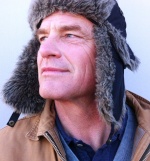
Arthur Joura- Member
 Re: American Bonsai at the NC Arboretum
Re: American Bonsai at the NC Arboretum
Arthur,
my response would always be ---------- actions speak louder than words - so I will wait and see what you create as Bonsai and how different it would be or similar to what amounts to - truly Natural Bonsai.
Will it be harmonious, balance/d or elegant and so on?
Should be enjoyable, I clap you on.


Thanks for an excellent chat!!
Stay well.
Khaimraj
my response would always be ---------- actions speak louder than words - so I will wait and see what you create as Bonsai and how different it would be or similar to what amounts to - truly Natural Bonsai.
Will it be harmonious, balance/d or elegant and so on?
Should be enjoyable, I clap you on.
Thanks for an excellent chat!!
Stay well.
Khaimraj
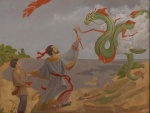
Khaimraj Seepersad- Member
 Re: American Bonsai at the NC Arboretum
Re: American Bonsai at the NC Arboretum
Blasphemy I say, pure and unabashed blasphemy!!! Off with your head!! 
I feel like I have been a part of this discussion with you for many years. I certainly agree with your assessment of current fashions. I admire and appreciate the many compositions you have created and continue to enhance that clearly demonstrate your unique interpretation of trees.
I look at some of my trees and know I/my trees suffer from exactly what you describe...influenced more by bonsai than natural trees. I've been conscious of this for some time and certainly have several plantings that also lean toward more realistic images. I honestly like both, and will probably always have a place in my garden for both.
Thanks again Arthur for always helping us to look deeper!!
John
I feel like I have been a part of this discussion with you for many years. I certainly agree with your assessment of current fashions. I admire and appreciate the many compositions you have created and continue to enhance that clearly demonstrate your unique interpretation of trees.
I look at some of my trees and know I/my trees suffer from exactly what you describe...influenced more by bonsai than natural trees. I've been conscious of this for some time and certainly have several plantings that also lean toward more realistic images. I honestly like both, and will probably always have a place in my garden for both.
Thanks again Arthur for always helping us to look deeper!!
John
jgeanangel- Member
 Re: American Bonsai at the NC Arboretum
Re: American Bonsai at the NC Arboretum
Great thread! if I may say.
You cannot imagine how much I appreciate this article, your time and your effort to communicate your thoughts here. I'm very grateful for that, Arthur.
As I'm reading with great interest, Thank you for making me think!
Arthur and every participant, do you mind if I copy some interesting (for me) excerpts of this thread for my personal use? You see, I belong to those elderly old fashioned who love reading printed hard copies and not screens In any case, please feel free to refuse.
In any case, please feel free to refuse.
Thank you Arthur, for taking the time to post here all those wonderful photos and corresponding descriptions.Arthur Joura wrote:... ...One of the primary reasons why I maintain this thread on the IBC, instead of having it exist as an independently operated, proper blog, is for the community aspect that exists on a public forum. It gets messy, sometimes even ugly, which can be discouraging, but there is also a value-added component provided by the free exchange of ideas that a forum facilitates... ...
You cannot imagine how much I appreciate this article, your time and your effort to communicate your thoughts here. I'm very grateful for that, Arthur.
As I'm reading with great interest, Thank you for making me think!
Arthur and every participant, do you mind if I copy some interesting (for me) excerpts of this thread for my personal use? You see, I belong to those elderly old fashioned who love reading printed hard copies and not screens

my nellie- Member
 Re: American Bonsai at the NC Arboretum
Re: American Bonsai at the NC Arboretum
Hello Arthur,
I have been reading your post with great interest. I have been struggling with how I could participate in this thead as I am having a difficult time understanding all the comments from you and others as to how it related to bonsai, combined with all the conversations you and I have had in the past. However, your last post has summed up nicely for me making perfect sense to what I have been feeling since I first met you.
In college I studied photography with an emphisis on Landscape photography. I considered myself to be creative, but never felt, or called myself and artist. I guess I felt, and still feel that I wanted to "reproduce" nature so that I could share with others what it is I saw. I wanted them to see it with as much detail as I had because to me the detail in nature was as important and the over all scene. Now this does not me I didn't from time to time allow the shutter to work a little slower on a beautiful waterfall, or babeling brook to give the water that flowing wispy look that showed the peaceful motion for the subject at hand. But still, I was reproducing what was already there and that is they way I wanted it. In an artistic program at school I was at times accused of not being artistic enough, or producing boaring nature photos, but for me if admiring the likes of Ansel Adams and Edward Weston was boaring then so be it.
I came to bonsai what I consider late in life. I created my first bonsai when I was 42 years old and like you everything I was told at the beginning releated to Japanese bonsai and while bonsai has given me a great apreciation for the culture, and I hope to visit there some day, I don't seem to have much urge anymore to create a japanese style bonsai. I appreciate them yes!, but I want something more, something that I can relate to in my own culture. Something that reminds me of "home" if you will, the places in nature that I have been and enjoyed, found peace. However, I struggle because every time I put a tree in a pot (most pots having asian influence) I start to think, "Ok this is my first branch, and the apex must go in this direction, and I must remove this branch because it breaks one of the rules....etc...etc. But I don't have much else to base my bonsai on but nature itself and breaking habits are hard.
Arthur you wrote:
I want to let you know that you are not alone in this ocean. I am bobbing around out there too and maybe I will bump into you and you can share more of you vision with me and help me become better at what I want to achive.
I would like to make one comment on a comment that Khaimarj said:
Not that Arthur needs defending, and he probably wouldn't want me to defend him, and given the fact that it is possible I have miss-interpreted the statement, but Arthur has already produces many works that are directly related to this topic. One I can think of right of and is a piece he did that I believe he called "Mt Mitchell". It is a landscape piece that represents the mountian and what he felt while there. I have been to Mt Mitchell in my life time and I can see without hesitation I totally related to this piece. My trip over Mt Mitchell was one I will never forget. As I ascended up the mountain it was sunny and a beautiful. As I got closer to the top it started snowing and the road really started to ice up and I thought for a while I would be spending the night in my car at the top, but I was able to proceed. As I decended down the other side the snow turned in to a Thunderstorm and then just rain. I thought myself how magnificent nature is and was amazed at what I had just experienced.
Well, I have hogged up enough bandwith for now, but I felt now was a time I could contribute something. Arthur, Please do not stop posting you thoughts and feeling on bonsai. I am in that ocean and I need to hear your voice so I can find my way.
Thanks
Stephen Krall
I have been reading your post with great interest. I have been struggling with how I could participate in this thead as I am having a difficult time understanding all the comments from you and others as to how it related to bonsai, combined with all the conversations you and I have had in the past. However, your last post has summed up nicely for me making perfect sense to what I have been feeling since I first met you.
In college I studied photography with an emphisis on Landscape photography. I considered myself to be creative, but never felt, or called myself and artist. I guess I felt, and still feel that I wanted to "reproduce" nature so that I could share with others what it is I saw. I wanted them to see it with as much detail as I had because to me the detail in nature was as important and the over all scene. Now this does not me I didn't from time to time allow the shutter to work a little slower on a beautiful waterfall, or babeling brook to give the water that flowing wispy look that showed the peaceful motion for the subject at hand. But still, I was reproducing what was already there and that is they way I wanted it. In an artistic program at school I was at times accused of not being artistic enough, or producing boaring nature photos, but for me if admiring the likes of Ansel Adams and Edward Weston was boaring then so be it.
I came to bonsai what I consider late in life. I created my first bonsai when I was 42 years old and like you everything I was told at the beginning releated to Japanese bonsai and while bonsai has given me a great apreciation for the culture, and I hope to visit there some day, I don't seem to have much urge anymore to create a japanese style bonsai. I appreciate them yes!, but I want something more, something that I can relate to in my own culture. Something that reminds me of "home" if you will, the places in nature that I have been and enjoyed, found peace. However, I struggle because every time I put a tree in a pot (most pots having asian influence) I start to think, "Ok this is my first branch, and the apex must go in this direction, and I must remove this branch because it breaks one of the rules....etc...etc. But I don't have much else to base my bonsai on but nature itself and breaking habits are hard.
Arthur you wrote:
I stop now and look back on all that I have written in this post, and I realize - I am swimming in the middle of a great ocean, far from land, and there is no one else around me. I could go on and on this way but there is no reason to do so, right here and right now. wrote:
I want to let you know that you are not alone in this ocean. I am bobbing around out there too and maybe I will bump into you and you can share more of you vision with me and help me become better at what I want to achive.
I would like to make one comment on a comment that Khaimarj said:
my response would always be ---------- actions speak louder than words - so I will wait and see what you create as Bonsai and how different it would be or similar to what amounts to - truly Natural Bonsai. wrote:
Not that Arthur needs defending, and he probably wouldn't want me to defend him, and given the fact that it is possible I have miss-interpreted the statement, but Arthur has already produces many works that are directly related to this topic. One I can think of right of and is a piece he did that I believe he called "Mt Mitchell". It is a landscape piece that represents the mountian and what he felt while there. I have been to Mt Mitchell in my life time and I can see without hesitation I totally related to this piece. My trip over Mt Mitchell was one I will never forget. As I ascended up the mountain it was sunny and a beautiful. As I got closer to the top it started snowing and the road really started to ice up and I thought for a while I would be spending the night in my car at the top, but I was able to proceed. As I decended down the other side the snow turned in to a Thunderstorm and then just rain. I thought myself how magnificent nature is and was amazed at what I had just experienced.
Well, I have hogged up enough bandwith for now, but I felt now was a time I could contribute something. Arthur, Please do not stop posting you thoughts and feeling on bonsai. I am in that ocean and I need to hear your voice so I can find my way.
Thanks
Stephen Krall

Stephen Krall- Member
 We Hold These Truths to be Self-evident
We Hold These Truths to be Self-evident
Thank you, Khaimraj, John G, my nellie and Stephen, for taking the time to share your thoughts!
My nellie, it is fine with me if you would like to print out what I have written. Thank you for taking enough of an interest to want to do that.
John, when I read your comment my mind flashed back to when I first become aware of you. It was in the mid-90's and I was reading a newsletter from the (now defunct) Bonsai Club of South Carolina. There was an article in there by some guy who had strayed across the state line and gone to visit Hawksbill Mountain, part of the Linville Gorge Wilderness in North Carolina. This writer was rhapsodizing about the Table Mountain Pines (Pinus pungens) he saw up there, how they were shaped by the extreme environment in which they live and were all dwarfed and twisted into amazing shapes. He was talking about studying these pines and viewing them as inspiration for bonsai designs. I thought, "well, here is a person who thinks like I do!" You were that writer, of course, so even back then you were being drawn to the natural example and thinking of how it might be possible to express it in bonsai form. I think this impulse is not so rare. Figuring out how to move away from rigid adherence to the basic design conventions of bonsai we were taught and toward the goal of an expression of personal experience, is still the great challenge. You have moved farther along that path than you credit yourself for doing. I still have that newsletter, by the way.
Steve, your line about "bobbing around out there" in the metaphorical ocean made me smile out loud! I suspect there is a duck or 2 floating nearby... I take seriously, though, your frustration at the difficulty of finding a way to go with bonsai as a creative medium that does not end up bringing you right back to the elemental bonsai design blueprint. Breaking away from these step-by-step instructions is no simple task, and it is made even more difficult by the fact that these rules, as we usually call them, represent a sound approach that has proven to produce reliably good results. Now, a reasonable person might reasonably ask, if these so-called rules work so well, why would you want to move away from them? I think it is pointless to answer this question. If a person is asking it, it means they should stay with what they know. If and when the time comes that an individual feels the need to experiment with the formula, they will do it. As for how to go forward from that point - well, good luck!
... That was a bit flippant of me, I admit. I am still finding my own way, so I am in no position to tell others how to go about it. I talk about the journey with you and other bonsai people I know every time we get together, and I am writing this thread and posting it here for anyone who has interest to read about it. That is the best I can do.
Khaimraj, if I had a dollar for every time I myself used the expression "actions speak louder than words"... I would still have to work a job for money, but I would be able to take off more often. Funny though, when I think about it, that saying is not entirely true. Words represent ideas, and ideas themselves can have great value long before it is possible to realize them in actions.
For example, back in 1776 this guy:

wrote some famous words: "We hold these truths to be self-evident, that all men are created equal, that they are endowed by their Creator with certain unalienable Rights, that among these are Life, Liberty and the pursuit of Happiness"
The fact that Thomas Jefferson was never able to live up to these words himself, and that the country he helped to found is still struggling to live up to them, does not take away from their value. And before anyone goes apoplectic, I am not claiming to be like Jefferson or equating one of the noblest expressions of human rights with the mundane suggestion that people might design their miniature trees in some way other than how they were taught. I am only pointing out that words can sometimes speak louder than actions, and that they sometimes have to, because actions can become stuck in their ways and oblivious to other possibilities.
Fortunately for me, my actions are already striving to live up to my words. I am actively developing a personal vernacular in bonsai design, based on the premiss that trees themselves have more to tell me about the nature of trees than do the conventions of a foreign aesthetic. But this is bonsai we are talking about, so it should be understood that any sort of meaningful change we try to introduce, to our own trees or to the overall concept, will only materialize slowly.
In the bonsai collection of the NC Arboretum, almost all of our plants started out being done by the conventional guidelines of bonsai design. They either came that way to us courtesy of the people who donated them, or were done that way by me to begin with before I started to have different ideas. So, added to the difficulty of conceiving of a new design concept is the necessity of overriding the existing design concept. Or, stated in another way, how do you take a bonsai that was designed to imitate the Japanese aesthetic and reorder it to look more like a tree in nature?
In another thread on this forum (here is a link: https://ibonsaiclub.forumotion.com/t12638-developing-a-persian-parrotia-with-arthur-joura) there is much information already available regarding this process. Anyone who is genuinely interested would do well to listen to the conversation between John Geanangel and I, presented in the 2 videos posted there. The Parrotia persica bonsai discussed on that thread is but one of several established trees in the Arboretum's collection currently being overhauled, and it will take years for it to reach fruition in its new design concept. For obvious reasons, I cannot do this with every bonsai in our collection! We have to have presentable trees to put on display in the Bonsai Exhibition Garden, and trees all wired up, and with limb spreaders and guy-wires and the like, planted in oversized pots or wooden boxes, do not fit the bill. Beyond that, some trees are best left just as they are. To try and change a tree that has 20 or 30 years of good development in the standard bonsai design formula is unnecessary and often unwise. I am for the "Big Tent" approach to bonsai - there is room for many different ideas. Bonsai in general, and bonsai at the NC Arboretum, need not be all one way or all another.
We also have in our bonsai holdings a few trees that began their initial training at a point after I began to move toward Naturalistic design. These trees, then, have been worked from the onset to follow the ideas embodied by the words I am now speaking and the concepts I am now promoting. They will take many years to reach maturity. Here are some images of one such project, an American Red Maple (Acer rubrum):
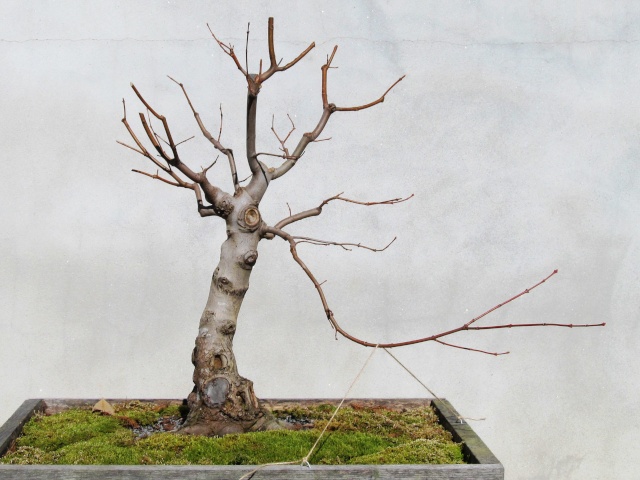

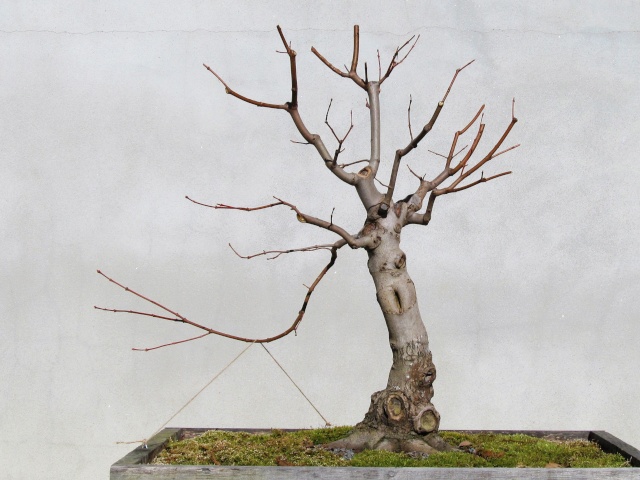
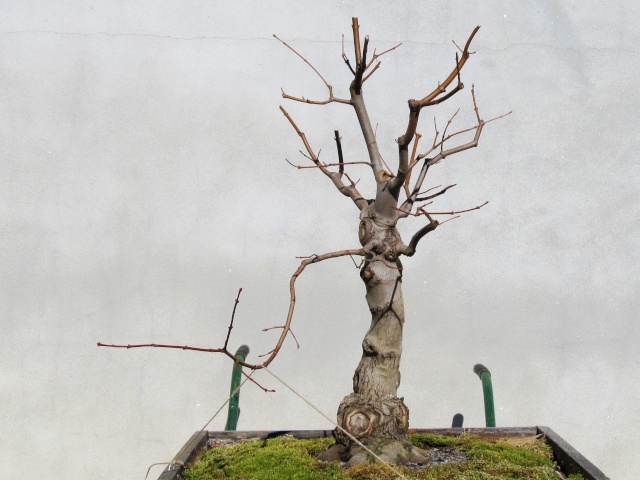
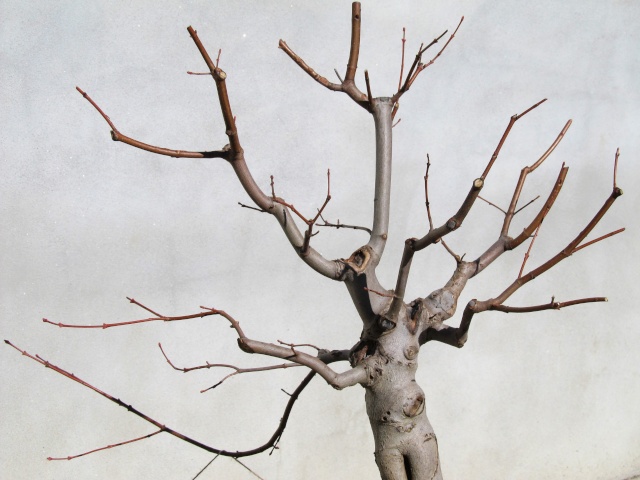
This tree was collected as a one year seedling, growing with a thousand others of its kind in a stopped up roof gutter. It grew for 5 years or so in progressively larger plastic pots, until I planted it in the ground for a period of 4 years. I think this is its 4th year in a grow box. Just a couple of months ago I moved it from a smaller box into the larger one it is in now, which measures about 4' X 2' X 6" deep (1.2m X .6m X .15m). The intent here is to develop a crown that is similar in its construction to the structure most often found on deciduous trees in nature. That is to say, a trunk line that divides into several different components that all lend parts of themselves to the overall shape of the upper crown of the tree, rather than a single line that runs from the base of the tree to the apex.
Please take note of the one limb that is lowest on the right hand side of the tree as presented in the first photograph. It is noticeably longer than any other on the tree and is being pulled down by a piece of string. The obvious intent here is to fatten this limb by allowing it to go unpruned at present, thus promoting greater strength and more rapid development. However, at present my other intent, less obvious, is to allow that branch to remain long (though not as long as it currently is) and do what it is being trained to do by the guy-wire (string). Such a branch may seem improbable, and by standard bonsai design ideals it would be strange and probably unacceptable. But this is an idea I got from studying trees in nature:
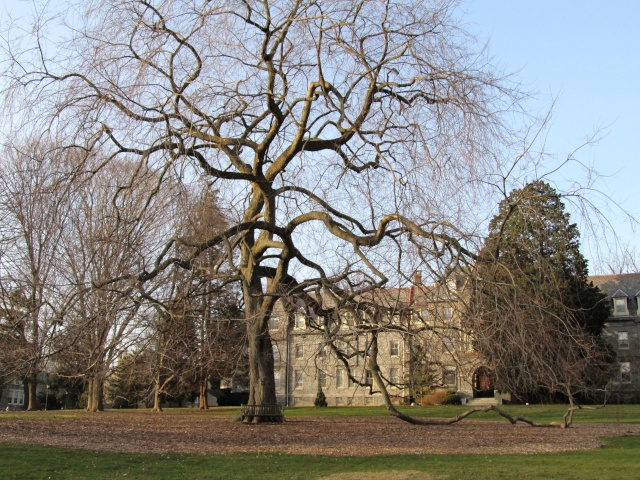
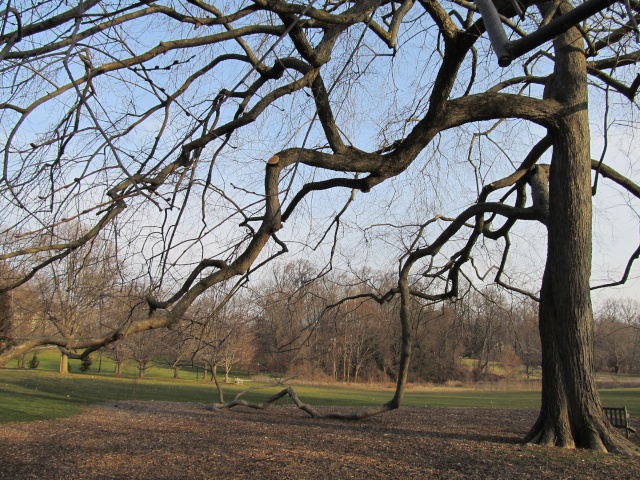
A few years back I was presenting a bonsai program at Haverford College in Pennsylvania, and I saw the tree pictured above, an American Elm (Ulmus americana), growing on the grounds of their campus. The tree is now 99 years old, meaning its in the prime of its life. If it had been growing in the forest it would not have the shape it has, and if it were growing somewhere other than in a college arboretum, it may well have been limbed up before it was ever able to assume its current shape. But it was growing out in the open and left to develop as it would. Do you look at that natural form and think it ugly? I think many people, interested in bonsai or not, would. I thought it was amazing, and I almost drove off the road when I first saw it. I went back later, after my talk, and took many pictures.
I did not set out with the idea of replicating the look of that long, sinuous branch, descending all the way down to the ground, but the thought of it came back to me one day when I was looking at this maple I am training to be a naturalistic bonsai. I recognized the opportunity is there with this tree to capture that look, and so, for now at least, I intend to do it. Mind, I am not trying to create a representation of that very tree on the Haverford campus, but using a piece of observed tree nature to inform my bonsai design process.
Is it a good idea? Will it work? Will people like the result? I do not know! But part of the adventure in bonsai, as in life, is finding out.
********************************************************************************************************************
By the way, today - February 22 - marks the one year anniversary of when I began this "Bonsai at the NC Arboretum" thread. My sincere thanks to all those who have made reading here a habit, and especially to those who have made a contribution to the ongoing discussion!
My nellie, it is fine with me if you would like to print out what I have written. Thank you for taking enough of an interest to want to do that.
John, when I read your comment my mind flashed back to when I first become aware of you. It was in the mid-90's and I was reading a newsletter from the (now defunct) Bonsai Club of South Carolina. There was an article in there by some guy who had strayed across the state line and gone to visit Hawksbill Mountain, part of the Linville Gorge Wilderness in North Carolina. This writer was rhapsodizing about the Table Mountain Pines (Pinus pungens) he saw up there, how they were shaped by the extreme environment in which they live and were all dwarfed and twisted into amazing shapes. He was talking about studying these pines and viewing them as inspiration for bonsai designs. I thought, "well, here is a person who thinks like I do!" You were that writer, of course, so even back then you were being drawn to the natural example and thinking of how it might be possible to express it in bonsai form. I think this impulse is not so rare. Figuring out how to move away from rigid adherence to the basic design conventions of bonsai we were taught and toward the goal of an expression of personal experience, is still the great challenge. You have moved farther along that path than you credit yourself for doing. I still have that newsletter, by the way.
Steve, your line about "bobbing around out there" in the metaphorical ocean made me smile out loud! I suspect there is a duck or 2 floating nearby... I take seriously, though, your frustration at the difficulty of finding a way to go with bonsai as a creative medium that does not end up bringing you right back to the elemental bonsai design blueprint. Breaking away from these step-by-step instructions is no simple task, and it is made even more difficult by the fact that these rules, as we usually call them, represent a sound approach that has proven to produce reliably good results. Now, a reasonable person might reasonably ask, if these so-called rules work so well, why would you want to move away from them? I think it is pointless to answer this question. If a person is asking it, it means they should stay with what they know. If and when the time comes that an individual feels the need to experiment with the formula, they will do it. As for how to go forward from that point - well, good luck!
... That was a bit flippant of me, I admit. I am still finding my own way, so I am in no position to tell others how to go about it. I talk about the journey with you and other bonsai people I know every time we get together, and I am writing this thread and posting it here for anyone who has interest to read about it. That is the best I can do.
Khaimraj, if I had a dollar for every time I myself used the expression "actions speak louder than words"... I would still have to work a job for money, but I would be able to take off more often. Funny though, when I think about it, that saying is not entirely true. Words represent ideas, and ideas themselves can have great value long before it is possible to realize them in actions.
For example, back in 1776 this guy:

wrote some famous words: "We hold these truths to be self-evident, that all men are created equal, that they are endowed by their Creator with certain unalienable Rights, that among these are Life, Liberty and the pursuit of Happiness"
The fact that Thomas Jefferson was never able to live up to these words himself, and that the country he helped to found is still struggling to live up to them, does not take away from their value. And before anyone goes apoplectic, I am not claiming to be like Jefferson or equating one of the noblest expressions of human rights with the mundane suggestion that people might design their miniature trees in some way other than how they were taught. I am only pointing out that words can sometimes speak louder than actions, and that they sometimes have to, because actions can become stuck in their ways and oblivious to other possibilities.
Fortunately for me, my actions are already striving to live up to my words. I am actively developing a personal vernacular in bonsai design, based on the premiss that trees themselves have more to tell me about the nature of trees than do the conventions of a foreign aesthetic. But this is bonsai we are talking about, so it should be understood that any sort of meaningful change we try to introduce, to our own trees or to the overall concept, will only materialize slowly.
In the bonsai collection of the NC Arboretum, almost all of our plants started out being done by the conventional guidelines of bonsai design. They either came that way to us courtesy of the people who donated them, or were done that way by me to begin with before I started to have different ideas. So, added to the difficulty of conceiving of a new design concept is the necessity of overriding the existing design concept. Or, stated in another way, how do you take a bonsai that was designed to imitate the Japanese aesthetic and reorder it to look more like a tree in nature?
In another thread on this forum (here is a link: https://ibonsaiclub.forumotion.com/t12638-developing-a-persian-parrotia-with-arthur-joura) there is much information already available regarding this process. Anyone who is genuinely interested would do well to listen to the conversation between John Geanangel and I, presented in the 2 videos posted there. The Parrotia persica bonsai discussed on that thread is but one of several established trees in the Arboretum's collection currently being overhauled, and it will take years for it to reach fruition in its new design concept. For obvious reasons, I cannot do this with every bonsai in our collection! We have to have presentable trees to put on display in the Bonsai Exhibition Garden, and trees all wired up, and with limb spreaders and guy-wires and the like, planted in oversized pots or wooden boxes, do not fit the bill. Beyond that, some trees are best left just as they are. To try and change a tree that has 20 or 30 years of good development in the standard bonsai design formula is unnecessary and often unwise. I am for the "Big Tent" approach to bonsai - there is room for many different ideas. Bonsai in general, and bonsai at the NC Arboretum, need not be all one way or all another.
We also have in our bonsai holdings a few trees that began their initial training at a point after I began to move toward Naturalistic design. These trees, then, have been worked from the onset to follow the ideas embodied by the words I am now speaking and the concepts I am now promoting. They will take many years to reach maturity. Here are some images of one such project, an American Red Maple (Acer rubrum):





This tree was collected as a one year seedling, growing with a thousand others of its kind in a stopped up roof gutter. It grew for 5 years or so in progressively larger plastic pots, until I planted it in the ground for a period of 4 years. I think this is its 4th year in a grow box. Just a couple of months ago I moved it from a smaller box into the larger one it is in now, which measures about 4' X 2' X 6" deep (1.2m X .6m X .15m). The intent here is to develop a crown that is similar in its construction to the structure most often found on deciduous trees in nature. That is to say, a trunk line that divides into several different components that all lend parts of themselves to the overall shape of the upper crown of the tree, rather than a single line that runs from the base of the tree to the apex.
Please take note of the one limb that is lowest on the right hand side of the tree as presented in the first photograph. It is noticeably longer than any other on the tree and is being pulled down by a piece of string. The obvious intent here is to fatten this limb by allowing it to go unpruned at present, thus promoting greater strength and more rapid development. However, at present my other intent, less obvious, is to allow that branch to remain long (though not as long as it currently is) and do what it is being trained to do by the guy-wire (string). Such a branch may seem improbable, and by standard bonsai design ideals it would be strange and probably unacceptable. But this is an idea I got from studying trees in nature:


A few years back I was presenting a bonsai program at Haverford College in Pennsylvania, and I saw the tree pictured above, an American Elm (Ulmus americana), growing on the grounds of their campus. The tree is now 99 years old, meaning its in the prime of its life. If it had been growing in the forest it would not have the shape it has, and if it were growing somewhere other than in a college arboretum, it may well have been limbed up before it was ever able to assume its current shape. But it was growing out in the open and left to develop as it would. Do you look at that natural form and think it ugly? I think many people, interested in bonsai or not, would. I thought it was amazing, and I almost drove off the road when I first saw it. I went back later, after my talk, and took many pictures.
I did not set out with the idea of replicating the look of that long, sinuous branch, descending all the way down to the ground, but the thought of it came back to me one day when I was looking at this maple I am training to be a naturalistic bonsai. I recognized the opportunity is there with this tree to capture that look, and so, for now at least, I intend to do it. Mind, I am not trying to create a representation of that very tree on the Haverford campus, but using a piece of observed tree nature to inform my bonsai design process.
Is it a good idea? Will it work? Will people like the result? I do not know! But part of the adventure in bonsai, as in life, is finding out.
********************************************************************************************************************
By the way, today - February 22 - marks the one year anniversary of when I began this "Bonsai at the NC Arboretum" thread. My sincere thanks to all those who have made reading here a habit, and especially to those who have made a contribution to the ongoing discussion!
Last edited by Arthur Joura on Sun Feb 23, 2014 4:02 am; edited 1 time in total

Arthur Joura- Member
 Re: American Bonsai at the NC Arboretum
Re: American Bonsai at the NC Arboretum
Thanks Arthur and happy birthday. Your birthday but we are the ones who have received the gift of your insight and ability to express yourself so wonderfully. Thanks

DougB- Member
 Re: American Bonsai at the NC Arboretum
Re: American Bonsai at the NC Arboretum
Arthur, thanks for your posts! Thank you, also, for sharing some of your own journey in Naturalistic styling. I like what's happening so far with your maple. That extra long, drooping branch looks like it just might make for a very interesting and natural composition. I look forward to seeing this tree's future progress.
Daygan- Member
 Eastern Redcedar
Eastern Redcedar
Thank you, Doug and Daygan, for your thoughtful words of support.
Continuing the discussion on observing and studying trees in nature and using the knowledge gained to inform one's bonsai styling, I would like to share with those who are interested a progression featuring a large, collected Eastern Redcedar (Juniperus virginiana). My friend Tom collected this tree from a site in North Carolina above 4,000 feet (1,219m) back in the late 1990's. He donated it to the Arboretum, and in 2001 we had Mr. Qingquan Zhao of China here on a visit and had him work on the tree in a public demonstration. The following photographs were made shortly before his presentation:
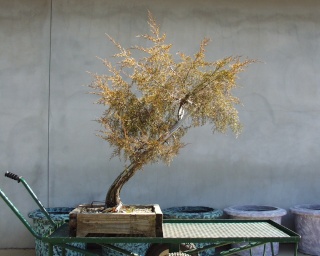
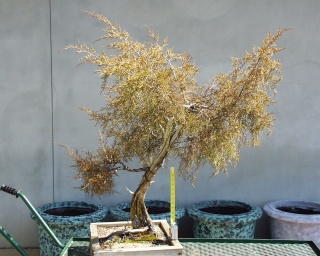
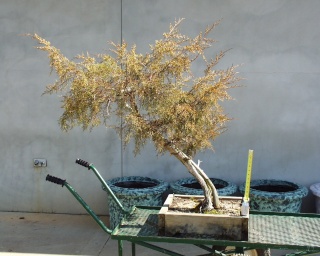
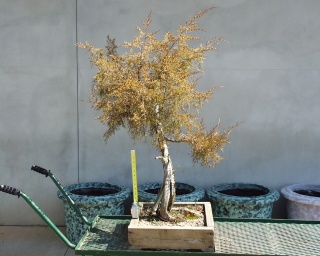
With a lack of thoroughness that has since thankfully become more rare, I did not take a follow-up set of images after Mr. Zhao's work. I regret this.
I do remember what happened afterwards, however. Most of the tree's foliage was removed and the plant was put into a bonsai container during the demonstration, so it was subjected to a lot of stress. In response, I allowed it to grow more or less unmolested for the remainder of 2001 and all of 2002. A recovery period after an intensive session wherein much is removed from the plant, is always a good idea. But letting it grow unrestrained for 2 entire growing seasons is usually not necessary, and in some cases might negate the styling work that was done in the first place. With this tree it was not a bad thing to do, because it is an older specimen and took longer to regain its vigor.
The next picture I have of this specimen is from 2003, and here we can see that it has become overgrown and has lost most of the shaping that Mr. Zhao had given it:
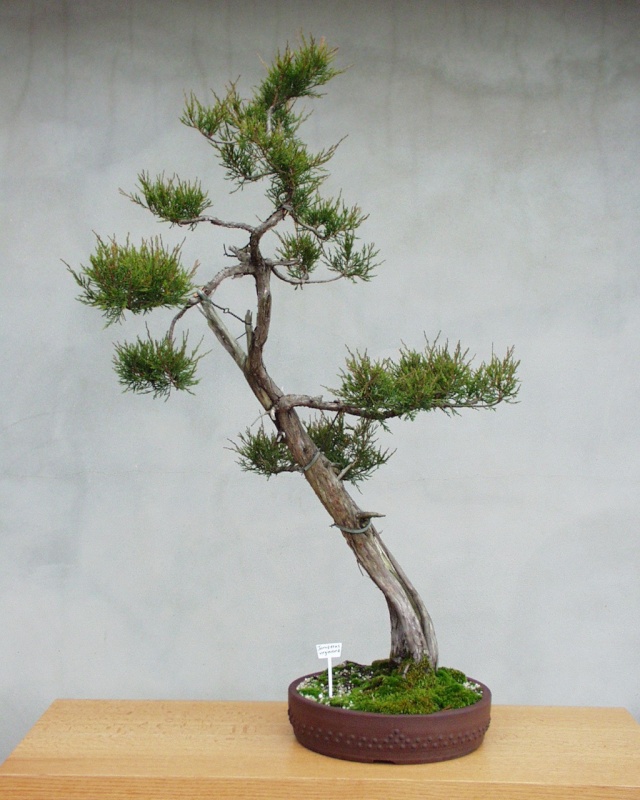
I say again so it will be well understood, this is not Mr. Zhao's work! He had 3 hours to whip some shape into a wild and unruly plant, and this image is 3 years later, after absolutely minimal maintenance. However, it is possible to see, to those who know how to look, an approximate idea of how Mr. Zhao approached the material. Although the tree has changed continually since then, even today it is still largely laid out according to the overall design structure Mr. Zhao gave it. He might not recognize it today, and he might not like the way it looks now, but some of his mind and vision still resides in this bonsai. This is valuable to me because I have the greatest respect for Mr. Zhao. We have a couple other pieces he designed, tray landscapes both, and these are kept much more in line with how he originally made them.
Back to the Redcedar - by 2007 it turned out to look like this (container by Robert Wallace):
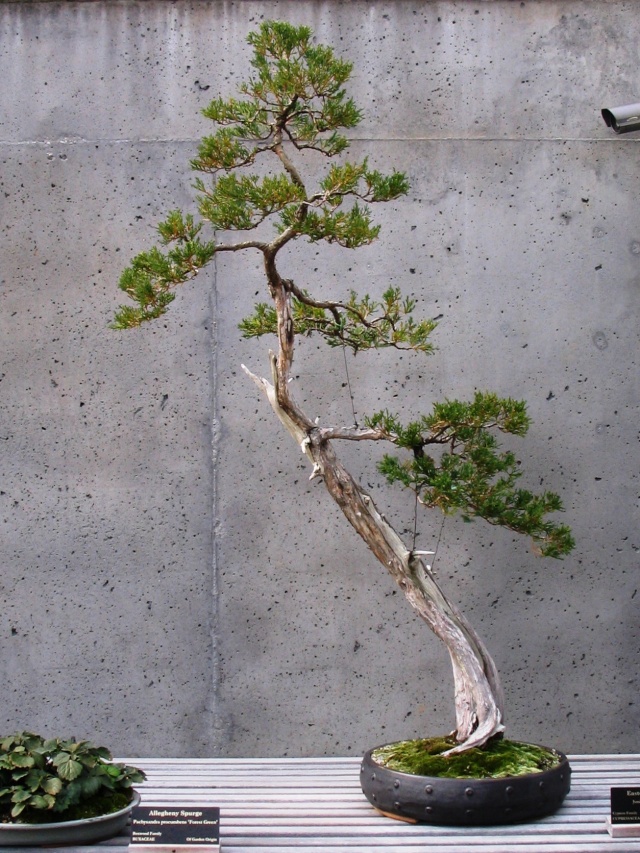
One of the difficulties when working with redcedars is the stiffness and often sparseness of their foliage. There is considerable variation between individuals within the species, and the foliage can range from just about impossible to manage to remarkably workable. Most specimens fall somewhere between those ends of the spectrum, and such is the case with this individual. An ongoing challenge with this tree has been to bring the foliage back in toward the trunk. It was pretty rangy when Mr. Zhao first tackled it, and it has taken a long time to make it less and less leggy in appearance.
In this image from 2010, we see the foliage masses filling out agreeably:
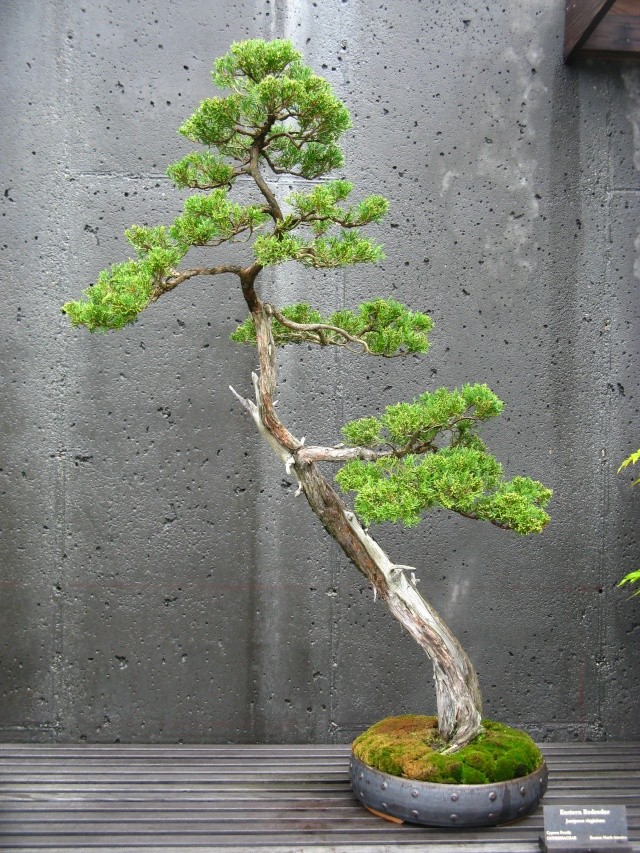
This image shows the tree looking about as good as it ever did in that particular styling. I had changed the feel of the tree from Mr. Zhao's original version, by removing some limbs and growing and shaping the foliage masses in a way that was certainly different from how he would have gone about it.
Somewhere about this time I started to dislike the look of this Redcedar. For people who have been reading along on this thread, I probably do not have to explain why. The tree was not put out on display the last 2 or 3 years, and sat more or less neglected in the hoop house. It did receive some attention, but mostly that amounted to chasing back shaggy growth and keeping it from getting completely out of shape.
Earlier this month, between lengthy periods of writing about painting, I overhauled this tree's design. Here is a set of images made just before the most recent styling session:
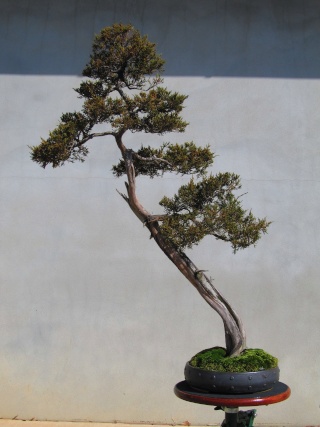

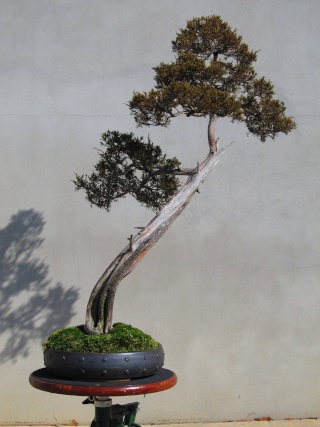
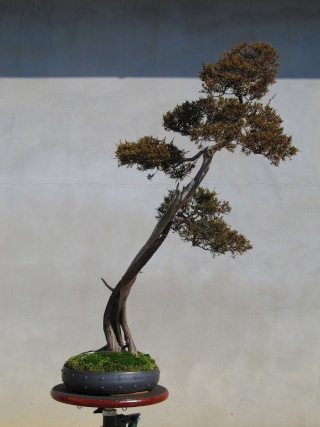
And here are the corresponding "after" views:
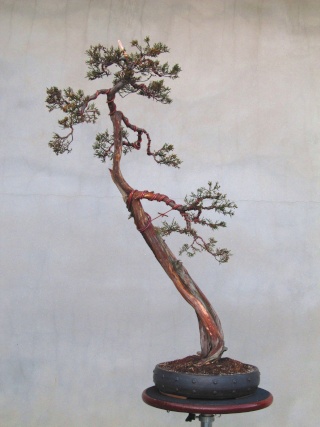
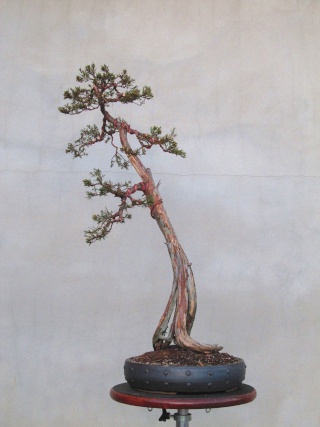
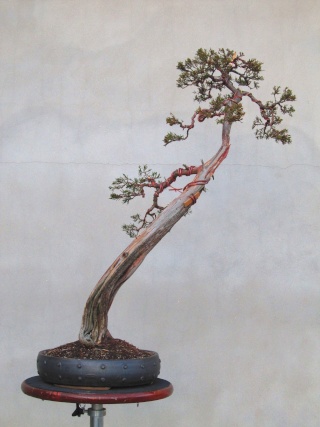
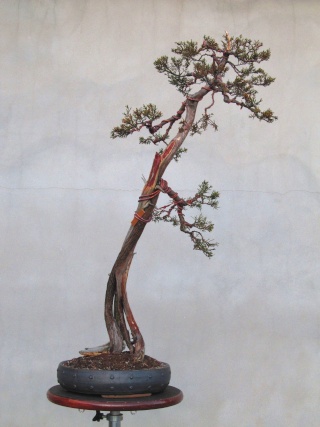
All the work that was done pertained to branches and foliage. This specimen has a good deal of deadwood on it, which has not been addressed as of yet. I do not suppose it will be for a while. When it is ultimately cleaned up and treated, it will create some drama in the trunk line. It will never be stark white, but it will certainly be more visible than it is now. The tree needs repotting and that will happen later in the growing season, and it will stay in the container it currently occupies. The planting angle may or may not change.
I was looking at the tree again just this morning. Although I am doing my best to work more 'in the round' now, making the tree present as well as possible when viewed from all directions, there is still a perspective I think is best. This is how I see it:
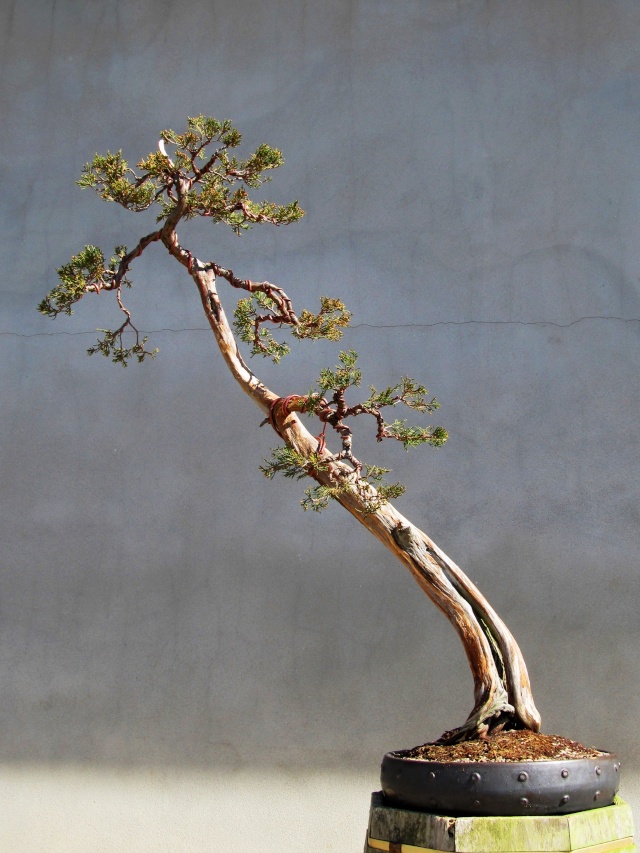
Perhaps this is how it should really be seen:
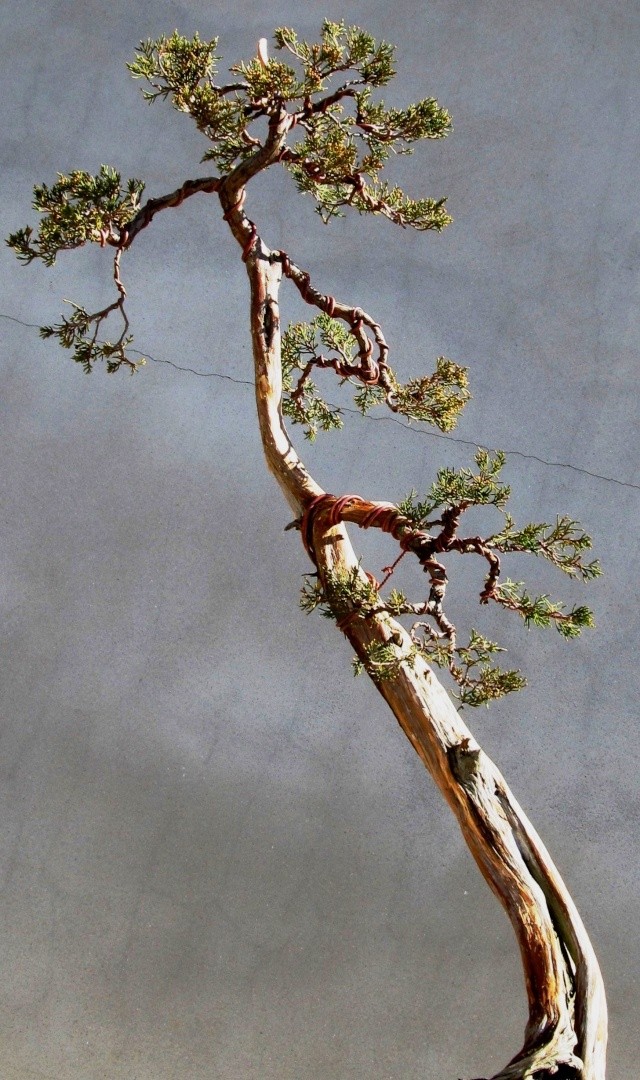
The following 2 images show before and after detail of the work done on the crown of the tree:
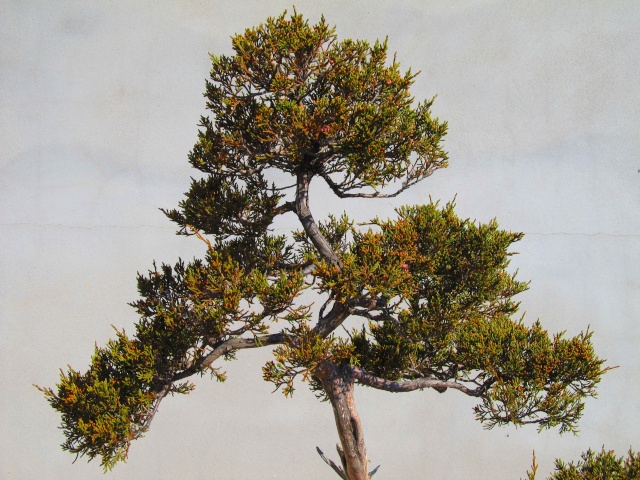
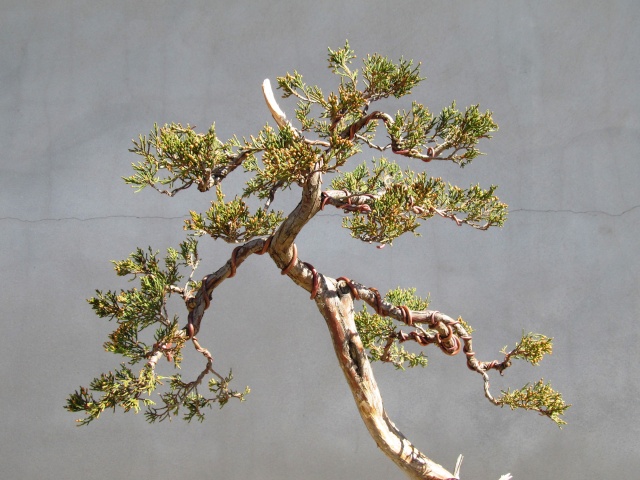
I very much like the new look for this tree! It has become more naturalistic. The configuration of the branches now reflects information I have gathered over years of looking at trees, and the overall image of the bonsai is one of greater plausibility. I can imagine seeing a tree similar to this in nature. It would be an amazing tree to see, for certain, but not unimaginable, as was the case with the way this tree looked before. Again and again I have seen collected junipers trained with their branches all slanting downward, a neat triangular configuration of foliage sitting atop a dramatic trunk. If you like such a look you are in luck! There are so many juniper bonsai out there done to that exact pattern. It is with great intention that this Redcedar has been shaped to not look like them.
Honesty compels me to also admit that it has not been shaped to look like an Eastern Redcedar, either - at least none I have ever seen. They are such common trees throughout the eastern US, primarily in Piedmont areas. Here are a couple of old specimens I have seen in my travels:


Venerable trees to be sure, but not so inspiring for bonsai, in my opinion. Sometimes you can see more craggy, even gnarly forms of redcedar in the higher elevations:
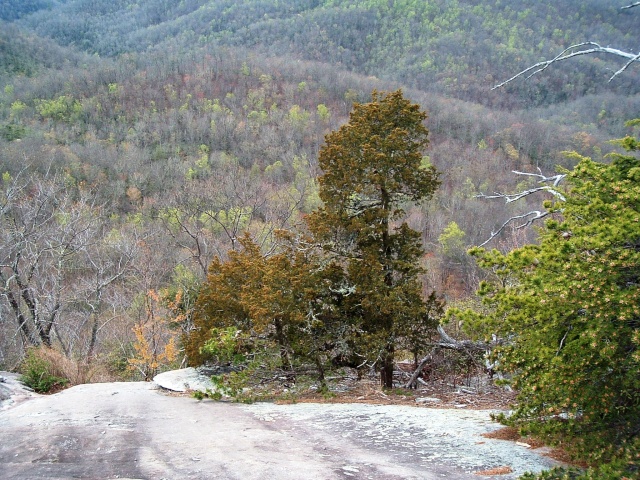

But even these more interesting redcedars were not what I had in mind as I worked on the Redcedar bonsai. I was thinking instead of pine trees. In my experience, it is not at all unusual to see junipers shaped in bonsai to resemble pine tree forms, or rather, highly idealized forms meant to symbolize pines.
Here are some photographs of old pine trees in NC, the first 2 being Longleaf Pines (Pinus palustris) and the 3rd a Loblolly (Pinus taeda):
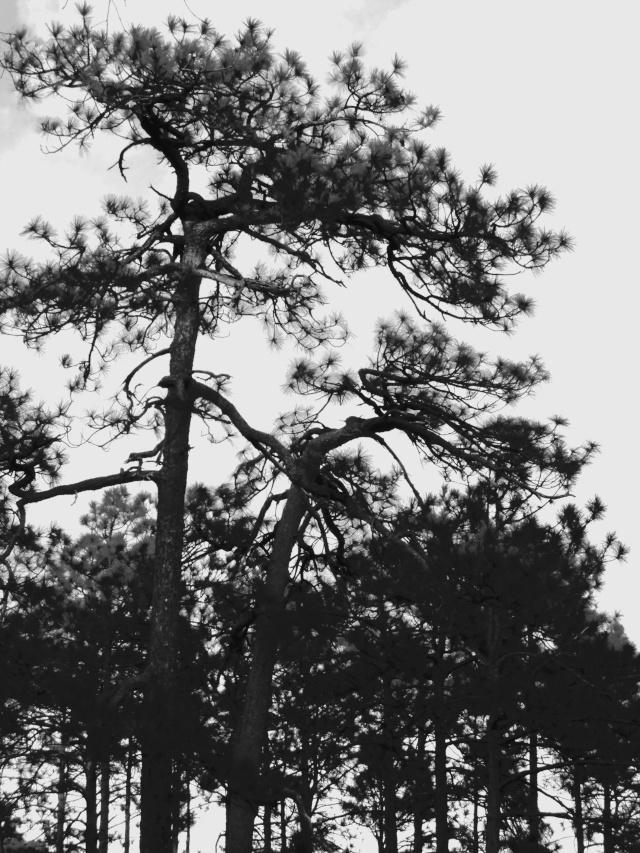


Works for me:

Continuing the discussion on observing and studying trees in nature and using the knowledge gained to inform one's bonsai styling, I would like to share with those who are interested a progression featuring a large, collected Eastern Redcedar (Juniperus virginiana). My friend Tom collected this tree from a site in North Carolina above 4,000 feet (1,219m) back in the late 1990's. He donated it to the Arboretum, and in 2001 we had Mr. Qingquan Zhao of China here on a visit and had him work on the tree in a public demonstration. The following photographs were made shortly before his presentation:




With a lack of thoroughness that has since thankfully become more rare, I did not take a follow-up set of images after Mr. Zhao's work. I regret this.
I do remember what happened afterwards, however. Most of the tree's foliage was removed and the plant was put into a bonsai container during the demonstration, so it was subjected to a lot of stress. In response, I allowed it to grow more or less unmolested for the remainder of 2001 and all of 2002. A recovery period after an intensive session wherein much is removed from the plant, is always a good idea. But letting it grow unrestrained for 2 entire growing seasons is usually not necessary, and in some cases might negate the styling work that was done in the first place. With this tree it was not a bad thing to do, because it is an older specimen and took longer to regain its vigor.
The next picture I have of this specimen is from 2003, and here we can see that it has become overgrown and has lost most of the shaping that Mr. Zhao had given it:

I say again so it will be well understood, this is not Mr. Zhao's work! He had 3 hours to whip some shape into a wild and unruly plant, and this image is 3 years later, after absolutely minimal maintenance. However, it is possible to see, to those who know how to look, an approximate idea of how Mr. Zhao approached the material. Although the tree has changed continually since then, even today it is still largely laid out according to the overall design structure Mr. Zhao gave it. He might not recognize it today, and he might not like the way it looks now, but some of his mind and vision still resides in this bonsai. This is valuable to me because I have the greatest respect for Mr. Zhao. We have a couple other pieces he designed, tray landscapes both, and these are kept much more in line with how he originally made them.
Back to the Redcedar - by 2007 it turned out to look like this (container by Robert Wallace):

One of the difficulties when working with redcedars is the stiffness and often sparseness of their foliage. There is considerable variation between individuals within the species, and the foliage can range from just about impossible to manage to remarkably workable. Most specimens fall somewhere between those ends of the spectrum, and such is the case with this individual. An ongoing challenge with this tree has been to bring the foliage back in toward the trunk. It was pretty rangy when Mr. Zhao first tackled it, and it has taken a long time to make it less and less leggy in appearance.
In this image from 2010, we see the foliage masses filling out agreeably:

This image shows the tree looking about as good as it ever did in that particular styling. I had changed the feel of the tree from Mr. Zhao's original version, by removing some limbs and growing and shaping the foliage masses in a way that was certainly different from how he would have gone about it.
Somewhere about this time I started to dislike the look of this Redcedar. For people who have been reading along on this thread, I probably do not have to explain why. The tree was not put out on display the last 2 or 3 years, and sat more or less neglected in the hoop house. It did receive some attention, but mostly that amounted to chasing back shaggy growth and keeping it from getting completely out of shape.
Earlier this month, between lengthy periods of writing about painting, I overhauled this tree's design. Here is a set of images made just before the most recent styling session:




And here are the corresponding "after" views:




All the work that was done pertained to branches and foliage. This specimen has a good deal of deadwood on it, which has not been addressed as of yet. I do not suppose it will be for a while. When it is ultimately cleaned up and treated, it will create some drama in the trunk line. It will never be stark white, but it will certainly be more visible than it is now. The tree needs repotting and that will happen later in the growing season, and it will stay in the container it currently occupies. The planting angle may or may not change.
I was looking at the tree again just this morning. Although I am doing my best to work more 'in the round' now, making the tree present as well as possible when viewed from all directions, there is still a perspective I think is best. This is how I see it:

Perhaps this is how it should really be seen:

The following 2 images show before and after detail of the work done on the crown of the tree:


I very much like the new look for this tree! It has become more naturalistic. The configuration of the branches now reflects information I have gathered over years of looking at trees, and the overall image of the bonsai is one of greater plausibility. I can imagine seeing a tree similar to this in nature. It would be an amazing tree to see, for certain, but not unimaginable, as was the case with the way this tree looked before. Again and again I have seen collected junipers trained with their branches all slanting downward, a neat triangular configuration of foliage sitting atop a dramatic trunk. If you like such a look you are in luck! There are so many juniper bonsai out there done to that exact pattern. It is with great intention that this Redcedar has been shaped to not look like them.
Honesty compels me to also admit that it has not been shaped to look like an Eastern Redcedar, either - at least none I have ever seen. They are such common trees throughout the eastern US, primarily in Piedmont areas. Here are a couple of old specimens I have seen in my travels:


Venerable trees to be sure, but not so inspiring for bonsai, in my opinion. Sometimes you can see more craggy, even gnarly forms of redcedar in the higher elevations:


But even these more interesting redcedars were not what I had in mind as I worked on the Redcedar bonsai. I was thinking instead of pine trees. In my experience, it is not at all unusual to see junipers shaped in bonsai to resemble pine tree forms, or rather, highly idealized forms meant to symbolize pines.
Here are some photographs of old pine trees in NC, the first 2 being Longleaf Pines (Pinus palustris) and the 3rd a Loblolly (Pinus taeda):



Works for me:


Arthur Joura- Member
 Re: American Bonsai at the NC Arboretum
Re: American Bonsai at the NC Arboretum
Arthur I love this styling! Looks natural and elegant. You've done well with this material.
tmmason10- Member
 Re: American Bonsai at the NC Arboretum
Re: American Bonsai at the NC Arboretum
Thanks Arthur. Love the tree, now. I particularly like the last B&W photo. Ansel Adams proved that color was not needed, in fact a detractor. And your B&W of this tree just reinforces what Ansel Adams and his magnificent photos taught us. thanks again have a great spring, if it ever get here.

DougB- Member
 Re: American Bonsai at the NC Arboretum
Re: American Bonsai at the NC Arboretum
Arthur,
I found this post particularly interesting on several levels. First, like you we have Eastern Red cedars all over the place here in coastal Virginia. You can swing a dead bonsai without hitting one. If have thought for last couple years how to approach this material and as you know I am trying one that you helped me with it in a workshop last September. They are native to our area and I think that something could be done with them, but you do not see a lot used. It was nice to see how you approached this material. Second, as I read through your post my thought about the cedar started off as "nice bonsai" but as I continued reading and looking at the progress you went through and the examples of trees in nature initial reaction of "nice bonsai" started to change and eventually became a reaction of "nice tree". Even though as you pointed out it does not look anything like a Eastern Red cedar in the wild, I was ok with that, because what you had done to the cedar started to make sense to me. I started to look at the cedar as a tree in nature and not a bonsai. I am not sure if this will make sense to others as I am still working on my thoughts about this, but I thought I would share my feelings.
Steve
I found this post particularly interesting on several levels. First, like you we have Eastern Red cedars all over the place here in coastal Virginia. You can swing a dead bonsai without hitting one. If have thought for last couple years how to approach this material and as you know I am trying one that you helped me with it in a workshop last September. They are native to our area and I think that something could be done with them, but you do not see a lot used. It was nice to see how you approached this material. Second, as I read through your post my thought about the cedar started off as "nice bonsai" but as I continued reading and looking at the progress you went through and the examples of trees in nature initial reaction of "nice bonsai" started to change and eventually became a reaction of "nice tree". Even though as you pointed out it does not look anything like a Eastern Red cedar in the wild, I was ok with that, because what you had done to the cedar started to make sense to me. I started to look at the cedar as a tree in nature and not a bonsai. I am not sure if this will make sense to others as I am still working on my thoughts about this, but I thought I would share my feelings.
Steve

Stephen Krall- Member
 Re: American Bonsai at the NC Arboretum
Re: American Bonsai at the NC Arboretum
Arthur, I met you here in Columbia a Few months ago at Ken's house and it was a real pleasure to get to watch you work in person!
I have spent the past few days reading through this thread pretty much in it's entirety- maybe I "scanned" a few paragraphs...- and all I can say is WOW, you have really put it all out there! What a great thread... I have visited the Arboretum a few times- most recently for the last Bonsai expo- and I have been impressed every time. You truly do wonderful work there!
I decided to respond because I have some experience collecting these Eastern Red Cedars you were talking about in your most recent post. My parents live in Beaufort SC and those trees grow like weeds in their area! Literally... A few years back, I decided it was time to collect some for Bonsai. I tried to get a fairly large one, but at the time I drove a Honda Accord and had to remove so much foliage just to fit it in the car that the tree didn't make it... The only ones that were successful were the smaller ones. My favorite story came about while collecting a pretty decent sized seedling with a little "wiggle" in it- my mother and I found this little guy growing in an open spot, looked like a great opportunity to get a nice one. We got to digging it out and found a large root below it that had to be cut to get enough roots with the tree we wanted to collect. No problem, I had some large bypass pruners so I jumped right in. It was the hardest root I had ever tried to cut! Odd because it wasn't THAT big, but knowing it was probably the root of a larger Red Cedar and that these trees have notoriously hard wood, I just increased the pressure. With my Mom urging me on, I switched angles to get more leverage, bowed up and finally got through the root with a sudden pop. For a brief second, I felt some relief having accomplished a difficult task that would allow me to claim my prize! That relief turned to puzzlement as I thought "gee that was the juiciest root I have ever cut" because there was an odd gurgling noise coming from said root... Followed by a sudden gush of unrelenting water! Yep... That tough root was the WATER PIPE to my parent's house! Oops! Needless to say, my bonding time with my mother on a Spring afternoon collecting trees together turned into some father son bonding time as he and I suddenly had a nice plumbing project to undertake... He griped about being torn away from the golf tournament he was watching, but it has given us a nice story to tell... And I still own the tree! It has never done well and I left it for dead at my rental home a few years ago when I moved to my new home, because all the foliage was brown... I Found it again by a compost heap when I was poking around in the yard there this Fall, collecting some trees I planted in the ground a few years back. It was not real happy, but living! So I have it in my yard in a pot now trying to decide what to do with it this Spring. It needs a repotting, doesn't have a ton of potential for bonsai, but has a story behind it that I like telling so I will try to rejuvenate it if I can...
I am telling you this story because my experience collecting and working on these trees has been that they are a difficult subject, but seeing your success with them has inspired me to try again! I have a limitless supply of these trees at my parents's home and I plan on grabbing a few more the next time I visit. Perhaps if I get some more to work on I will be lucky enough to see you again and I can ask some questions about their care.
Thanks so much for this thread, I hope you understand how much it means to people like myself to have a venue we can access to get this kind of information, insight and philosophical discussion.
I have spent the past few days reading through this thread pretty much in it's entirety- maybe I "scanned" a few paragraphs...- and all I can say is WOW, you have really put it all out there! What a great thread... I have visited the Arboretum a few times- most recently for the last Bonsai expo- and I have been impressed every time. You truly do wonderful work there!
I decided to respond because I have some experience collecting these Eastern Red Cedars you were talking about in your most recent post. My parents live in Beaufort SC and those trees grow like weeds in their area! Literally... A few years back, I decided it was time to collect some for Bonsai. I tried to get a fairly large one, but at the time I drove a Honda Accord and had to remove so much foliage just to fit it in the car that the tree didn't make it... The only ones that were successful were the smaller ones. My favorite story came about while collecting a pretty decent sized seedling with a little "wiggle" in it- my mother and I found this little guy growing in an open spot, looked like a great opportunity to get a nice one. We got to digging it out and found a large root below it that had to be cut to get enough roots with the tree we wanted to collect. No problem, I had some large bypass pruners so I jumped right in. It was the hardest root I had ever tried to cut! Odd because it wasn't THAT big, but knowing it was probably the root of a larger Red Cedar and that these trees have notoriously hard wood, I just increased the pressure. With my Mom urging me on, I switched angles to get more leverage, bowed up and finally got through the root with a sudden pop. For a brief second, I felt some relief having accomplished a difficult task that would allow me to claim my prize! That relief turned to puzzlement as I thought "gee that was the juiciest root I have ever cut" because there was an odd gurgling noise coming from said root... Followed by a sudden gush of unrelenting water! Yep... That tough root was the WATER PIPE to my parent's house! Oops! Needless to say, my bonding time with my mother on a Spring afternoon collecting trees together turned into some father son bonding time as he and I suddenly had a nice plumbing project to undertake... He griped about being torn away from the golf tournament he was watching, but it has given us a nice story to tell... And I still own the tree! It has never done well and I left it for dead at my rental home a few years ago when I moved to my new home, because all the foliage was brown... I Found it again by a compost heap when I was poking around in the yard there this Fall, collecting some trees I planted in the ground a few years back. It was not real happy, but living! So I have it in my yard in a pot now trying to decide what to do with it this Spring. It needs a repotting, doesn't have a ton of potential for bonsai, but has a story behind it that I like telling so I will try to rejuvenate it if I can...
I am telling you this story because my experience collecting and working on these trees has been that they are a difficult subject, but seeing your success with them has inspired me to try again! I have a limitless supply of these trees at my parents's home and I plan on grabbing a few more the next time I visit. Perhaps if I get some more to work on I will be lucky enough to see you again and I can ask some questions about their care.
Thanks so much for this thread, I hope you understand how much it means to people like myself to have a venue we can access to get this kind of information, insight and philosophical discussion.
Eric Group- Member
 Re: American Bonsai at the NC Arboretum
Re: American Bonsai at the NC Arboretum
Hello Arthur,
I have not been around IBC for a while myself, but found this thread yesterday and have read pretty much everything in it in the past two days when the opportunity was there. You present a very refreshing take on bonsai. I read with interest your early introduction to the National Arboretum, as that is where I started to acquire an interest in bonsai. Now, as it happens, I am running a club that can call Janet Lanman an esteemed member. I didnt know it at the time, but when I joined the club over 20 years ago, the membership roster had the who's who in the NBF and the National Arboretum. Unfortunately many have passed, but I consider myself lucky to have been a fledgling when they were the veterans of the bonsai scene in and around DC. Felix was there from time to time escorting notable guest artists.
Anyway, it is with anxious anticipation that I will hopefully meet you in May at the PBA Festival, as I have enrolled in a workshop headed by you one day, and Rodney Clemons the next. This will be my own "little bit of heaven" weekend. I thoroughly enjoyed reading about your beginnings and journey through the years in Asheville. Thank you for a great trip, and see you soon.
I have not been around IBC for a while myself, but found this thread yesterday and have read pretty much everything in it in the past two days when the opportunity was there. You present a very refreshing take on bonsai. I read with interest your early introduction to the National Arboretum, as that is where I started to acquire an interest in bonsai. Now, as it happens, I am running a club that can call Janet Lanman an esteemed member. I didnt know it at the time, but when I joined the club over 20 years ago, the membership roster had the who's who in the NBF and the National Arboretum. Unfortunately many have passed, but I consider myself lucky to have been a fledgling when they were the veterans of the bonsai scene in and around DC. Felix was there from time to time escorting notable guest artists.
Anyway, it is with anxious anticipation that I will hopefully meet you in May at the PBA Festival, as I have enrolled in a workshop headed by you one day, and Rodney Clemons the next. This will be my own "little bit of heaven" weekend. I thoroughly enjoyed reading about your beginnings and journey through the years in Asheville. Thank you for a great trip, and see you soon.
Last edited by lordy on Thu Mar 13, 2014 3:04 pm; edited 1 time in total (Reason for editing : Correcting details after indepth research on one topic.)
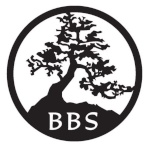
lordy- Member
 Re: American Bonsai at the NC Arboretum
Re: American Bonsai at the NC Arboretum
Hi Arthur
I read till my head hurts, Google to fill in some of the blanks.......I know nothing on the subject, can't contribute, but your effort is definitely appreciated, every small thing I learn is something I didn't used to know.....
Thank you...
So, you have noticed that this current phase of my thread is receiving "only token responses"? You may be correct that the subject is "too deep" for many, but I am not worried about it, because there may be other reasons, as well. With this entire enterprise (that is, maintaining this thread on the IBC) my starting assumption has been that the audience for what I have to say is quite small. The portion of the overall population that knows or cares anything about bonsai is minimal, and this forum is read by only a tiny fraction of those people. Out of that minuscule slice of a minuscule slice, the portion of people who are interested in even considering the possibility that there may be more to bonsai than what the conventional view tells us there is, is a pitiful minority. When you take that number, whatever it is, and subtract from it the people who are disinclined to comment in the first place, or who cannot comment because they read on this forum but do not belong to it, the number left may not be enough to fill the seats in an average size minivan.
I might be discouraged by this, but for a couple of considerations: 1) I personally benefit from writing all this stuff, because it forces me to concentrate and distill my ideas for the sake of effective communication; and, 2) when you put a message in a bottle and toss it into the ocean, there is no telling where it will wind up and who's eyes might eventually see it.
I read till my head hurts, Google to fill in some of the blanks.......I know nothing on the subject, can't contribute, but your effort is definitely appreciated, every small thing I learn is something I didn't used to know.....
Thank you...
GerhardGerber- Member
 Re: American Bonsai at the NC Arboretum
Re: American Bonsai at the NC Arboretum
“The configuration of the branches now reflects information I have gathered over years of looking at trees, and the overall image of the bonsai is one of greater plausibility. I can imagine seeing a tree similar to this in nature. It would be an amazing tree to see, for certain, but not unimaginable, as was the case with the way this tree looked before”.
“Honesty compels me to also admit that it has not been shaped to look like an Eastern Red Cedar, either - at least none I have ever seen. They are such common trees throughout the eastern US, primarily in Piedmont areas.”
Hi Arthur,
I’m one of the lurkers who read but rarely comment…. thinking that I have little value to contribute….or that we couldn’t put our thoughts down in writing so eloquently as you do.
However, your last post/discussion (highlighted sections above) hits home for me as it’s the same reasoning I look for i.e. a more natural form in my trees.
Working in the woods for nearly 40 years in the PNW I have seen and observed many specimens that allow me to repeat your term “reflects information gathered over the years looking at trees”.
To me the transformation of this ERC shows/illustrates the many common features of ancient trees that struggle to survive in their environment (regardless of species). They aren’t thriving by any means for they have usually adapted to the extremes of climatic conditions combined by the limited nutritional value of the microsite they are living in. Therefor many common features include; lots of deadwood, gnarly twisted branches with limited foliage, scars (shari) from branches being broken off from decay, wind or heavy snow etc. So yes this tree may not reflect any ERC you have seen but it does resonate to us in that it reflects an ancient tree that one could see in the wild.
This is a great post….keep it going.
Sincerely
Graham
“Honesty compels me to also admit that it has not been shaped to look like an Eastern Red Cedar, either - at least none I have ever seen. They are such common trees throughout the eastern US, primarily in Piedmont areas.”
Hi Arthur,
I’m one of the lurkers who read but rarely comment…. thinking that I have little value to contribute….or that we couldn’t put our thoughts down in writing so eloquently as you do.
However, your last post/discussion (highlighted sections above) hits home for me as it’s the same reasoning I look for i.e. a more natural form in my trees.
Working in the woods for nearly 40 years in the PNW I have seen and observed many specimens that allow me to repeat your term “reflects information gathered over the years looking at trees”.
To me the transformation of this ERC shows/illustrates the many common features of ancient trees that struggle to survive in their environment (regardless of species). They aren’t thriving by any means for they have usually adapted to the extremes of climatic conditions combined by the limited nutritional value of the microsite they are living in. Therefor many common features include; lots of deadwood, gnarly twisted branches with limited foliage, scars (shari) from branches being broken off from decay, wind or heavy snow etc. So yes this tree may not reflect any ERC you have seen but it does resonate to us in that it reflects an ancient tree that one could see in the wild.
This is a great post….keep it going.
Sincerely
Graham
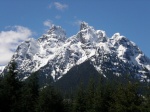
gman- Member
 Re: American Bonsai at the NC Arboretum
Re: American Bonsai at the NC Arboretum
Hello Arthur –
As I have posted before, I really enjoy reading your posts and the responses that they engender. I hope your posts continue for a great while. They contribute hugely to the collective development of the IBC community!
I read with interest your posts regarding what I will refer to here as the iconography of “treeness” within various artistic traditions and how these might represent an “accurate” representation of “treeness” in bonsai. I have spent some time in considering a response because I am very respectful of the time and thought you put into each submission.
Given the above, I think there is a construct which may have been omitted which is abstraction. Quoting Wikipedia “Abstraction is a process by which concepts are derived from the usage and classification of literal ("real" or "concrete") concepts, first principles, or other methods.”
Bonsai is an abstraction of “treeness”. In the abstracted sense, “treeness” cannot be separated from the cultural reality in which it was generated. What I am saying is that bonsai are not trees, they are representations of trees, and as such they are subject to the constraints of abstraction which are inherently cultural. I truly enjoy the various representations of “treeness” which you have provided! But, dare I venture here, you and I share a relatively similar cultural heritage. Another individual with a divergent cultural heritage may have a very different concept of “treeness” based upon abstractions which are prevalent in her culture.
As children, across cultures, we see trees as green lollipops atop brown trunks (you have shown various representations). As we grow older and become ingrained in our respective cultures we see trees as iconic objects imbued with meaning. Sometime this remains the lollipop ideal (e.g. some of the medieval images you have posted), and in other times this becomes a different representation of “treeness” imbued with meaning and nuance.
In the end, what I am trying to say (perhaps without terseness) is that the idea of “tree” is what bonsai tries to impart. And the idea of “tree” is constrained by the reality of abstraction – which is culturally driven!
My belief is that there can never be a universal ideal bonsai, just as there can never be a universal ideal tree. (Unless, god forbid, a number of projected dystopian realities come to be…)
Let us each create our own abstractions of “treeness” from within our own capacities and cultures and share these abstractions within the global community. In so doing we will expand our horticultural knowledge as well as our knowledge (if darkly) of other cultural paradigms. If and when we raise one paradigm of “treeness” as the standard of all “treeness” we risk cutting ourselves off from the richness of diverse opinion and diverse cultures.
If it becomes necessary or advantageous to compare and contrast horticultural and design skills with others in competition, then sobeit. However, I opine that such endeavors should be understood to occur within one (or clearly indicated multiple) culturally relevant abstractions of “treeness.”
Thank you again for your insightful and provocative posts. This is why I delight in this forum with its divergent and diverse viewpoints ! Just as trees are multivariate – so are we!
Yours!
David B.
As I have posted before, I really enjoy reading your posts and the responses that they engender. I hope your posts continue for a great while. They contribute hugely to the collective development of the IBC community!
I read with interest your posts regarding what I will refer to here as the iconography of “treeness” within various artistic traditions and how these might represent an “accurate” representation of “treeness” in bonsai. I have spent some time in considering a response because I am very respectful of the time and thought you put into each submission.
Given the above, I think there is a construct which may have been omitted which is abstraction. Quoting Wikipedia “Abstraction is a process by which concepts are derived from the usage and classification of literal ("real" or "concrete") concepts, first principles, or other methods.”
Bonsai is an abstraction of “treeness”. In the abstracted sense, “treeness” cannot be separated from the cultural reality in which it was generated. What I am saying is that bonsai are not trees, they are representations of trees, and as such they are subject to the constraints of abstraction which are inherently cultural. I truly enjoy the various representations of “treeness” which you have provided! But, dare I venture here, you and I share a relatively similar cultural heritage. Another individual with a divergent cultural heritage may have a very different concept of “treeness” based upon abstractions which are prevalent in her culture.
As children, across cultures, we see trees as green lollipops atop brown trunks (you have shown various representations). As we grow older and become ingrained in our respective cultures we see trees as iconic objects imbued with meaning. Sometime this remains the lollipop ideal (e.g. some of the medieval images you have posted), and in other times this becomes a different representation of “treeness” imbued with meaning and nuance.
In the end, what I am trying to say (perhaps without terseness) is that the idea of “tree” is what bonsai tries to impart. And the idea of “tree” is constrained by the reality of abstraction – which is culturally driven!
My belief is that there can never be a universal ideal bonsai, just as there can never be a universal ideal tree. (Unless, god forbid, a number of projected dystopian realities come to be…)
Let us each create our own abstractions of “treeness” from within our own capacities and cultures and share these abstractions within the global community. In so doing we will expand our horticultural knowledge as well as our knowledge (if darkly) of other cultural paradigms. If and when we raise one paradigm of “treeness” as the standard of all “treeness” we risk cutting ourselves off from the richness of diverse opinion and diverse cultures.
If it becomes necessary or advantageous to compare and contrast horticultural and design skills with others in competition, then sobeit. However, I opine that such endeavors should be understood to occur within one (or clearly indicated multiple) culturally relevant abstractions of “treeness.”
Thank you again for your insightful and provocative posts. This is why I delight in this forum with its divergent and diverse viewpoints ! Just as trees are multivariate – so are we!
Yours!
David B.
David Brunner- Member
 Acer palmatum 'Structural Puzzle'
Acer palmatum 'Structural Puzzle'
Ahh, springtime... when a middle aged man's fancy turns to thoughts of the impossibility of keeping up with everything that needs doing!
Thank you to tmmason10, DougB, Stephen, Eric, lordy, Gerhard, Graham and David, for commenting and keeping this thread going while I was not available to contribute to it.
Eric - I enjoyed your story about cutting the root that gushed water. I could relate, because I one time cut a root that carried all my neighbor's phone conversations. To you, and to Stephen, and to anyone else who has an interest in Eastern Redcedar (Juniperus virginiana) as bonsai, I say this: Redcedar is usable as bonsai, but they are not such wonderful subjects. They tend to be stiff and coarse in their habit and foliage, and they take forever to put on any size when in training, even when grown in the ground. The best hope for them as bonsai is to find one in the wild that has some age and character in the trunk line, collect it and work on developing the branching and foliage. That is what was done with the Redcedar in my previous post, and what I am doing with several others we have in the collection. Even if you are lucky enough to come across such a specimen you can expect it to take many years before shaping up. If I was going to produce a juniper bonsai from a very young plant, Redcedar would be one of my last choices, regardless of how abundant they may be. I think 10 years of work with a young 'Parsonii' would yield better results than 20 years with a young virginiana.
lordy - I am glad you found your way back to the IBC to read this thread. Janet Lanman is one of the most cultured, intelligent and enjoyable people I have had the good fortune of meeting, in bonsai or any other area of interest. When next you see her, please give her my fond regards. People in the D.C. area who love bonsai are so fortunate to have the National Bonsai and Penjing Museum in their backyard, not to mention all the knowledgeable and talented people who are associated with that institution! I look forward to meeting you next May at the PBA convention.
Graham - Thank you for confirming what I supposed to be true - that people who have first-hand knowledge of trees in nature will recognize true tree-ness in a bonsai that has it. Part of the problem, if indeed it should be labeled as such, is that relatively few people are so familiar with trees in the first place.
David - I re-read your post several times to be sure I was correctly following your thoughts. I do not feel comfortable intellectualizing to such a degree, especially about bonsai, which I prefer to experience from an emotional and sensual perspective. However, I have no disagreement with viewing bonsai as an abstraction of trees in nature. Within the broad category of abstraction there are degrees of greater and lesser abstraction. In bonsai I personally favor less abstraction, which is generally expressed as "naturalism". When you write: "Bonsai is an abstraction of “treeness”. In the abstracted sense, “treeness” cannot be separated from the cultural reality in which it was generated. What I am saying is that bonsai are not trees, they are representations of trees, and as such they are subject to the constraints of abstraction which are inherently cultural." I can only agree. My point (and I expect you understand this) is that I am not of Japanese, or Chinese, or any other Asian culture, so abstracting tree-ness to the standards of any of those cultures is not sensible or appealing to me. I prefer to shape abstract trees based on my own personal experience of real trees, here in my own country, under the happy influence of my own culture. Each to their own! There is plenty of room for all kinds of divergent ideas under the Bonsai Big Tent.
In the weeks since I last posted on this thread, I have spent much of my time knee deep in severed limbs and used medium out in my workspace. Even with the considerable amount of work I do out of season, this time of year is a seemingly endless rush of pruning and repotting in advance of active growth. It is a race I always lose to one degree or another. Each specimen I work on has a story of its own, and as such could be the subject of a post of its own. I never have to worry about finding something to write about. The problem, always, is making the time.
Today I want to share with you one of the Arboretum's Japanese Maple (Acer palmatum) bonsai. I recently pruned it and applied some wire, and sometime in the next week or so it will be repotted:

This specimen came to us from eastern Pennsylvania. It was donated by a fine old gentleman named Kent Kise, a resident of Lancaster, PA, who was put in touch with the NC Arboretum through our mutual friend, Roger Lehman of Meco Bonsai. Mr. Kise grew this bonsai for more than 30 years. He did much of the styling work himself, with help time to time from visiting experts and knowledgeable acquaintances, and it is fair to say that he thought of this tree as one of the best in his collection. The age and character of this plant made it attractive to me, and I was intrigued by its design. I say "intrigued" and not, for example, "impressed" or "enchanted" or some other more clearly positive word, because there was something in the construction of this tree that did not sit right with me. Here is a photograph made of the maple at the time of donation, in October of 2008:

As is my customary practice with any substantial tree that comes to our collection, I did nothing immediately to dramatically alter Mr. Kise's maple. I did begin working with it, however, the following spring, making a few adjustments to how the tree was situated in the Sara Raynor container. I moved it to the left in the pot, turned it slightly clockwise and tilted it a little to the right:

The tree felt more visually comfortable to me in this new position. I trimmed back some of the more leggy growth, but did not entirely remove any larger branches. The above picture was made in March of 2009. This next image is from November of 2010:

In the years I have been caring for it, this maple has produced good, but not outstanding, autumn color. There is a lot of variation in seed grown maples, which is what this one is. I think it looks very attractive in spring (April, 2011):
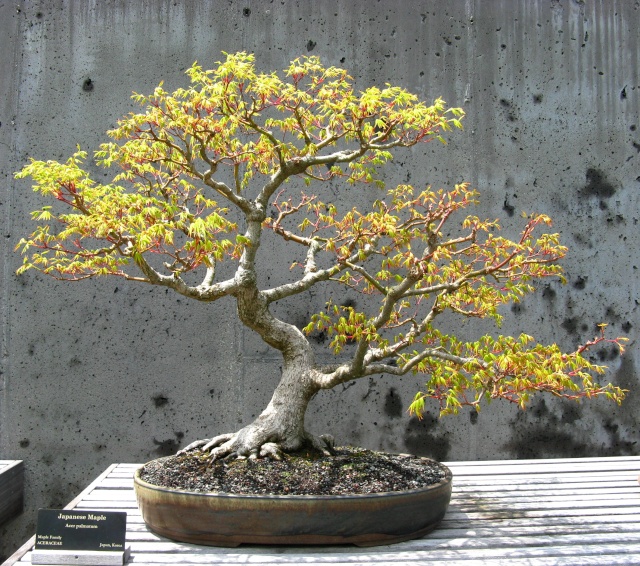
And just to round out the seasons, here is a summer image, taken in June of 2012:

Let us look again at its current appearance, this time in a 360 degree clockwise rotation:




Here are a couple of images showing before and after spring cleanup pruning on one of the primary branches:


Here is a close-up of the base of the tree, seen from the tree's most commonly viewed perspective:

Like the tree itself, this base has a good deal of character, yet it is far from perfect. The asymmetry of it might be seen as unattractive, but even more problematic is the very noticeable hump sticking up on the right hand side. Of course, the hump could be removed and the resulting scar would eventually callous over. I expect some people would choose to do that if they were growing this particular tree, and perhaps they would try to alleviate the asymmetry, as well. But I have no intentions of doing so. It has flaws but I can live with the base as it is. Is this a bad approach? Am I being slack in not doing everything I can to make this tree as excellent as it can possibly be? You can answer these rhetorical questions however you like, but my feeling is in line with a quote attributed to the psychologist William James: "The art of being wise is the art of knowing what to overlook."
One issue with this bonsai that I am having difficulty overlooking, and this is the very same thing that registered uncomfortably with me the first time I laid eyes upon it, is the configuration of branches at the very heart of the tree's composition:
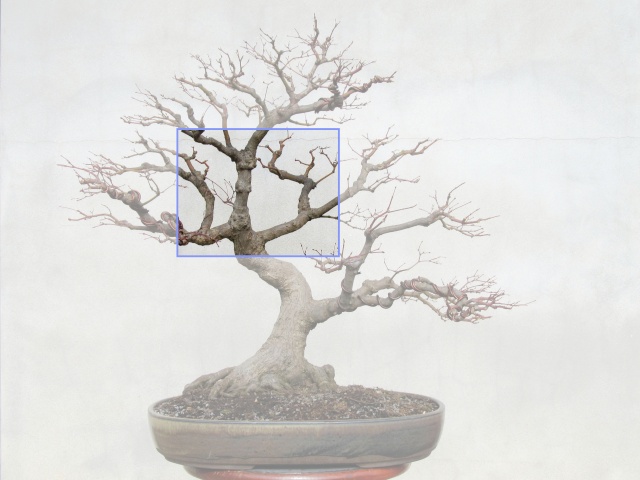
That area of the tree looks awkward to me. My eye catches there as it moves through the composition, and I think it is unpleasant to look at. Located where it is, it is impossible not to look at it for approximately half a year, while the tree is without leaves. I have tried different perspectives to see if there is a way of presenting this bonsai that downplays the unfortunate branch arrangement, but I have not found such a view. The first branch on the left side is a major part of the problem, and has a fundamentally poor structure of its own:

Any time you have a big branch with a "T" intersection, you probably have a problem! This configuration is the result of a decision made long ago, wherein part of a side branch was utilized to become a back branch, as well. Such convenient cheating is commonplace in bonsai design, and typically becomes uglier and more noticeable the older the tree gets. It is particularly unfortunate that this should occur when one is working with a young maple, because it is almost always unnecessary, given the miracle of back-budding. Still, this is an ordinary enough fact of life - choices made for convenience and expedience at an early stage of the journey can cost most dearly later on.
So I have been looking at the structure of this tree and thinking about it for more than 5 years now. I have whittled down parts of the offending branches over time, but the central flaw in their basic arrangement remains intact. It is a puzzle, a structural puzzle:





In the time I have been studying over this puzzle, a little glimmer of hope for a future solution has appeared and it takes the form of the fore-mentioned miracle of back budding. Even on an older tree such as this, every year there are many new buds that pop out on various places all over the branches and trunk. Typically they are mostly rubbed off before they can develop, but sometimes they appear in a fortunate spot and are allowed to develop. A few years ago a bud showed up on the trunk of this tree, on the left hand side and toward the rear when the bonsai is viewed from its most favorable perspective. In other words, adventitious growth has occurred right where I would most desire to add a branch. I have let it develop, so now it is entering its 3rd year of growth:

This little branch has a long way to go before it can be called upon to fill the void that would be created by pruning the already established branch, but it can go about its business for awhile as the existent branch remains in place. Then one day the big cut gets made, and the young replacement branch is there, ready to grow into the void.
Here is a Photoshopped view of what might be the eventual result:

Those looking closely will note that I also took the liberty of adjusting the relationship between the back branch on the right side and the trunk, which is another weak area of the current design. Again, this move entails growing out a piece that already exists until it is large enough to allow removing an offending, existent part of the branch, in this case the piece that crosses back against the line of the trunk.
It should be understood by everyone that such Photoshopped images are as much wishful thinking or fantasy as they are representations of practical possibilities. In many cases these "virtual" images are made long distance by helpful people who have no familiarity with the actual bonsai. Many alterations can be made on a photographic image that are not in reality possible when dealing with the living plant. In this case, as the grower of the bonsai in question, I know what I am proposing is doable, yet the actual results will inevitably be different. At best, the Photoshopped image can only crudely suggest how the tree might end up looking.
As long as we are playing this game, here is another workable alternative for the bonsai in question:

In this version, too, the new back branch has been allowed to grow and develop, and the alteration has been made on the back branch on the right side, but here the entire first branch on the left side has been taken off. This creates a highly dramatic asymmetry to the silhouette of the tree. Such an imbalanced look will not appeal to everyone, and I am not certain I care for it myself, but it is an interesting possibility and I could live with it that way.
In the long ago, dark days before home computers, if a person wanted to visually represent an idea they might draw a simple picture. It is still possible to do this, and now, for convenience sake, it can be done using Photoshop! So, what follows are some simple drawings, each representing a different take on the design of this Japanese Maple bonsai.
First, here is a representation of the existing structure:

Here is the first possibility I proposed, utilizing the new back branch and removing a chunk of the first branch on the left:

Here is the alternate possibility previously discussed, with the entire first branch on the left removed:

Another doable option, although this one holds little appeal in my view:

Of course, I could strip off all the branches and start from scratch, making a proper banzai out of it:

I am not certain what solution I will eventually apply to this structural puzzle. I do know that whatever I decide to do, I will take my time getting there, making no decisions until I am fully comfortable with all the possible ramifications. In the meantime, I can easily enjoy the individuality and character of this old bonsai just as it is:

Thank you to tmmason10, DougB, Stephen, Eric, lordy, Gerhard, Graham and David, for commenting and keeping this thread going while I was not available to contribute to it.
Eric - I enjoyed your story about cutting the root that gushed water. I could relate, because I one time cut a root that carried all my neighbor's phone conversations. To you, and to Stephen, and to anyone else who has an interest in Eastern Redcedar (Juniperus virginiana) as bonsai, I say this: Redcedar is usable as bonsai, but they are not such wonderful subjects. They tend to be stiff and coarse in their habit and foliage, and they take forever to put on any size when in training, even when grown in the ground. The best hope for them as bonsai is to find one in the wild that has some age and character in the trunk line, collect it and work on developing the branching and foliage. That is what was done with the Redcedar in my previous post, and what I am doing with several others we have in the collection. Even if you are lucky enough to come across such a specimen you can expect it to take many years before shaping up. If I was going to produce a juniper bonsai from a very young plant, Redcedar would be one of my last choices, regardless of how abundant they may be. I think 10 years of work with a young 'Parsonii' would yield better results than 20 years with a young virginiana.
lordy - I am glad you found your way back to the IBC to read this thread. Janet Lanman is one of the most cultured, intelligent and enjoyable people I have had the good fortune of meeting, in bonsai or any other area of interest. When next you see her, please give her my fond regards. People in the D.C. area who love bonsai are so fortunate to have the National Bonsai and Penjing Museum in their backyard, not to mention all the knowledgeable and talented people who are associated with that institution! I look forward to meeting you next May at the PBA convention.
Graham - Thank you for confirming what I supposed to be true - that people who have first-hand knowledge of trees in nature will recognize true tree-ness in a bonsai that has it. Part of the problem, if indeed it should be labeled as such, is that relatively few people are so familiar with trees in the first place.
David - I re-read your post several times to be sure I was correctly following your thoughts. I do not feel comfortable intellectualizing to such a degree, especially about bonsai, which I prefer to experience from an emotional and sensual perspective. However, I have no disagreement with viewing bonsai as an abstraction of trees in nature. Within the broad category of abstraction there are degrees of greater and lesser abstraction. In bonsai I personally favor less abstraction, which is generally expressed as "naturalism". When you write: "Bonsai is an abstraction of “treeness”. In the abstracted sense, “treeness” cannot be separated from the cultural reality in which it was generated. What I am saying is that bonsai are not trees, they are representations of trees, and as such they are subject to the constraints of abstraction which are inherently cultural." I can only agree. My point (and I expect you understand this) is that I am not of Japanese, or Chinese, or any other Asian culture, so abstracting tree-ness to the standards of any of those cultures is not sensible or appealing to me. I prefer to shape abstract trees based on my own personal experience of real trees, here in my own country, under the happy influence of my own culture. Each to their own! There is plenty of room for all kinds of divergent ideas under the Bonsai Big Tent.
In the weeks since I last posted on this thread, I have spent much of my time knee deep in severed limbs and used medium out in my workspace. Even with the considerable amount of work I do out of season, this time of year is a seemingly endless rush of pruning and repotting in advance of active growth. It is a race I always lose to one degree or another. Each specimen I work on has a story of its own, and as such could be the subject of a post of its own. I never have to worry about finding something to write about. The problem, always, is making the time.
Today I want to share with you one of the Arboretum's Japanese Maple (Acer palmatum) bonsai. I recently pruned it and applied some wire, and sometime in the next week or so it will be repotted:

This specimen came to us from eastern Pennsylvania. It was donated by a fine old gentleman named Kent Kise, a resident of Lancaster, PA, who was put in touch with the NC Arboretum through our mutual friend, Roger Lehman of Meco Bonsai. Mr. Kise grew this bonsai for more than 30 years. He did much of the styling work himself, with help time to time from visiting experts and knowledgeable acquaintances, and it is fair to say that he thought of this tree as one of the best in his collection. The age and character of this plant made it attractive to me, and I was intrigued by its design. I say "intrigued" and not, for example, "impressed" or "enchanted" or some other more clearly positive word, because there was something in the construction of this tree that did not sit right with me. Here is a photograph made of the maple at the time of donation, in October of 2008:

As is my customary practice with any substantial tree that comes to our collection, I did nothing immediately to dramatically alter Mr. Kise's maple. I did begin working with it, however, the following spring, making a few adjustments to how the tree was situated in the Sara Raynor container. I moved it to the left in the pot, turned it slightly clockwise and tilted it a little to the right:

The tree felt more visually comfortable to me in this new position. I trimmed back some of the more leggy growth, but did not entirely remove any larger branches. The above picture was made in March of 2009. This next image is from November of 2010:

In the years I have been caring for it, this maple has produced good, but not outstanding, autumn color. There is a lot of variation in seed grown maples, which is what this one is. I think it looks very attractive in spring (April, 2011):

And just to round out the seasons, here is a summer image, taken in June of 2012:

Let us look again at its current appearance, this time in a 360 degree clockwise rotation:




Here are a couple of images showing before and after spring cleanup pruning on one of the primary branches:


Here is a close-up of the base of the tree, seen from the tree's most commonly viewed perspective:

Like the tree itself, this base has a good deal of character, yet it is far from perfect. The asymmetry of it might be seen as unattractive, but even more problematic is the very noticeable hump sticking up on the right hand side. Of course, the hump could be removed and the resulting scar would eventually callous over. I expect some people would choose to do that if they were growing this particular tree, and perhaps they would try to alleviate the asymmetry, as well. But I have no intentions of doing so. It has flaws but I can live with the base as it is. Is this a bad approach? Am I being slack in not doing everything I can to make this tree as excellent as it can possibly be? You can answer these rhetorical questions however you like, but my feeling is in line with a quote attributed to the psychologist William James: "The art of being wise is the art of knowing what to overlook."
One issue with this bonsai that I am having difficulty overlooking, and this is the very same thing that registered uncomfortably with me the first time I laid eyes upon it, is the configuration of branches at the very heart of the tree's composition:

That area of the tree looks awkward to me. My eye catches there as it moves through the composition, and I think it is unpleasant to look at. Located where it is, it is impossible not to look at it for approximately half a year, while the tree is without leaves. I have tried different perspectives to see if there is a way of presenting this bonsai that downplays the unfortunate branch arrangement, but I have not found such a view. The first branch on the left side is a major part of the problem, and has a fundamentally poor structure of its own:

Any time you have a big branch with a "T" intersection, you probably have a problem! This configuration is the result of a decision made long ago, wherein part of a side branch was utilized to become a back branch, as well. Such convenient cheating is commonplace in bonsai design, and typically becomes uglier and more noticeable the older the tree gets. It is particularly unfortunate that this should occur when one is working with a young maple, because it is almost always unnecessary, given the miracle of back-budding. Still, this is an ordinary enough fact of life - choices made for convenience and expedience at an early stage of the journey can cost most dearly later on.
So I have been looking at the structure of this tree and thinking about it for more than 5 years now. I have whittled down parts of the offending branches over time, but the central flaw in their basic arrangement remains intact. It is a puzzle, a structural puzzle:





In the time I have been studying over this puzzle, a little glimmer of hope for a future solution has appeared and it takes the form of the fore-mentioned miracle of back budding. Even on an older tree such as this, every year there are many new buds that pop out on various places all over the branches and trunk. Typically they are mostly rubbed off before they can develop, but sometimes they appear in a fortunate spot and are allowed to develop. A few years ago a bud showed up on the trunk of this tree, on the left hand side and toward the rear when the bonsai is viewed from its most favorable perspective. In other words, adventitious growth has occurred right where I would most desire to add a branch. I have let it develop, so now it is entering its 3rd year of growth:

This little branch has a long way to go before it can be called upon to fill the void that would be created by pruning the already established branch, but it can go about its business for awhile as the existent branch remains in place. Then one day the big cut gets made, and the young replacement branch is there, ready to grow into the void.
Here is a Photoshopped view of what might be the eventual result:

Those looking closely will note that I also took the liberty of adjusting the relationship between the back branch on the right side and the trunk, which is another weak area of the current design. Again, this move entails growing out a piece that already exists until it is large enough to allow removing an offending, existent part of the branch, in this case the piece that crosses back against the line of the trunk.
It should be understood by everyone that such Photoshopped images are as much wishful thinking or fantasy as they are representations of practical possibilities. In many cases these "virtual" images are made long distance by helpful people who have no familiarity with the actual bonsai. Many alterations can be made on a photographic image that are not in reality possible when dealing with the living plant. In this case, as the grower of the bonsai in question, I know what I am proposing is doable, yet the actual results will inevitably be different. At best, the Photoshopped image can only crudely suggest how the tree might end up looking.
As long as we are playing this game, here is another workable alternative for the bonsai in question:

In this version, too, the new back branch has been allowed to grow and develop, and the alteration has been made on the back branch on the right side, but here the entire first branch on the left side has been taken off. This creates a highly dramatic asymmetry to the silhouette of the tree. Such an imbalanced look will not appeal to everyone, and I am not certain I care for it myself, but it is an interesting possibility and I could live with it that way.
In the long ago, dark days before home computers, if a person wanted to visually represent an idea they might draw a simple picture. It is still possible to do this, and now, for convenience sake, it can be done using Photoshop! So, what follows are some simple drawings, each representing a different take on the design of this Japanese Maple bonsai.
First, here is a representation of the existing structure:

Here is the first possibility I proposed, utilizing the new back branch and removing a chunk of the first branch on the left:

Here is the alternate possibility previously discussed, with the entire first branch on the left removed:

Another doable option, although this one holds little appeal in my view:

Of course, I could strip off all the branches and start from scratch, making a proper banzai out of it:

I am not certain what solution I will eventually apply to this structural puzzle. I do know that whatever I decide to do, I will take my time getting there, making no decisions until I am fully comfortable with all the possible ramifications. In the meantime, I can easily enjoy the individuality and character of this old bonsai just as it is:


Arthur Joura- Member
 Re: American Bonsai at the NC Arboretum
Re: American Bonsai at the NC Arboretum
I think photoshop option one is the best of the options presented.
Remove that part of the branch shooting straight up and let the new one in the back grow out.
Remove that part of the branch shooting straight up and let the new one in the back grow out.
Eric Group- Member
 Re: American Bonsai at the NC Arboretum
Re: American Bonsai at the NC Arboretum
Arthur, another fantastic post. I liked the focus on paintings in relations to bonsai but I much more prefer these types of posts about styling with real examples. I think you have the right approach for appreciating this old bonsai for what it is while you figure out where best to take it in the future.
tmmason10- Member
 Re: American Bonsai at the NC Arboretum
Re: American Bonsai at the NC Arboretum
Arthur, I am just wondering how much you take into account the originators design when making these changes? I think that most of the directions of your virts take that into account, but the latter ones, seem to me to go a bit far from the original design. And in so doing (for me at least) take away the individuality that is the reason the tree was special to begin with. The first fixes seem to better respect the trees character and make it better, but not so different...
I do agree that something should be done, as in all bonsai, there is always something to work on... but the question remains, how far to change?
I do agree that something should be done, as in all bonsai, there is always something to work on... but the question remains, how far to change?
JudyB- Member
 Stone Mountain
Stone Mountain
Thank you to John, Eric, Tom and Judy for taking the time to reply to my last post. Judy, to answer your question - a variety of considerations go into the decision to change the design of any bonsai on which I work. The design idea of the person, or people, who previously worked on the tree matters to me but is rarely the determining factor. Mostly I want to make the tree look as good as I can, without being obsessive about it. This thread captures, as well as I am able to express it, all the varied streams of influence that inform my design process. Those who read here with any regularity know that the natural example is becoming an ever greater inspiration for me.
Which segues nicely into today's post, which is more or less a photo essay.
Spring, in addition to being the time when there is so much to do with the bonsai in the collection and the plants in the garden landscape, is also a highly active time of year for presenting bonsai educational programing for clubs and conventions. A couple of weeks ago I went to Roanoke, VA for just that purpose, and made an interesting side trip. I have been presenting programs to the Hinoki Bonsai Society in Roanoke on an annual basis for the past dozen years, and I think on every one of those trips I have made a point of venturing away from the direct Interstate route and taking the opportunity to do some back country exploring. There is an abundance of beautiful, Southern Appalachian scenery between Asheville and Roanoke! This year I set my sights on visiting one of North Carolina's State Parks - Stone Mountain - where I had never previously been:

Stone Mountain State Park is located in Wilkes and Allegheny Counties, a fairly rural section of North Carolina, not too far from the boarder with Virginia. The Blue Ridge Parkway skirts along its northern periphery. The park covers more than 14,100 acres, but I was on a very limited time schedule and was able to see only a tiny fraction of it. I picked out a short trail, 1.5 miles (2.4km), up to a small mountain top, and then the same trail back. As the trail started out, it passed through a nice stand of old White Pines (Pinus strobus), with a dense growth of Rosebay Rhododendron (Rhododendron maximum) for an understory, but it was a cloudy day and in the shade of the pines my camera was useless. As the elevation increased the pines gave way to hardwoods, and there were many oaks:

It is hard to tell, looking at the photographs, but these were some sizable, old trees. There was one Chestnut Oak (Quercus prinus) right near the trail that was particularly impressive. It was easily 4ft. (1.2m) in diameter at a height of 4ft. above ground, and had the characteristic rough, deeply fissured bark found on mature trees of this species:

It was impossible for me to get all of this tree in one shot, which is usually the case when trying to photograph big trees in the forest. Although it does not come even close to giving a proper sense of how impressive this specimen was, here is a look up into the looming canopy:

I hurried along with one eye on the clock, which is a terrible way to take a walk in the woods, and made the top of the mountain in a short while. There I came across this tree, an Eastern Redcedar (Juniperus virginiana) and I began to have the feeling I had picked a good trail:
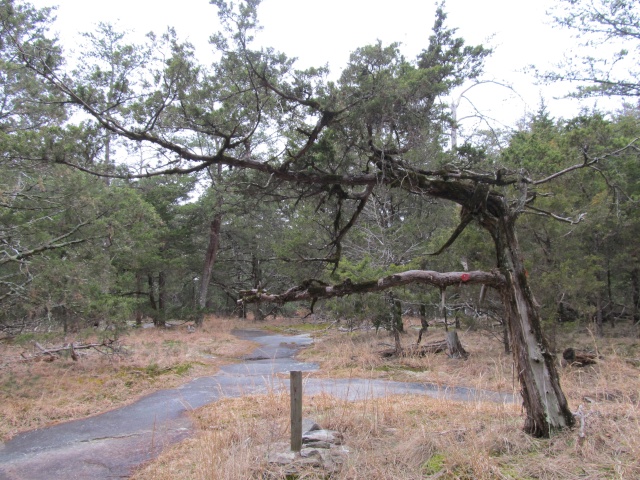
What might appear in the photograph to be a sidewalk of some sort, of concrete or asphalt, is actually exposed granite. Here is a closeup of the section where the trunk of the tree makes a 90 degree angle:

Here is the same tree, seen from the opposite side:
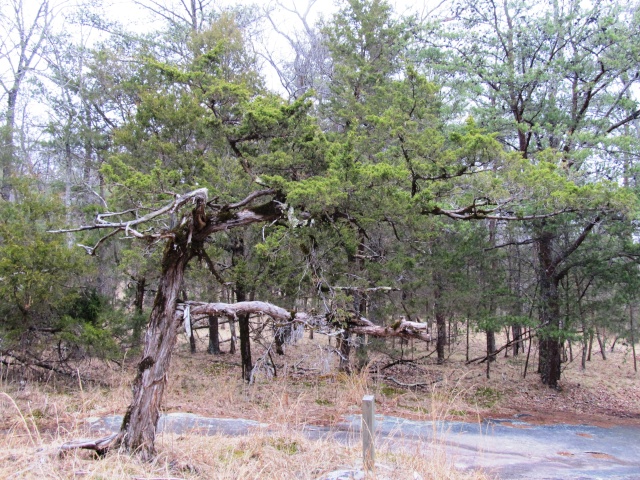
When I come across trees such as this, I always wonder how they might work as bonsai. Not in the sense of lifting it off the mountain and planting it in a gigantic pot, but rather as a model for shaping a much smaller tree. This is an example, I think, of a tree form that many bonsai critics would find unacceptable, mostly because of its rigid lines and the sharp right angle.
Moving past this sentinel tree, along the granite "walkway", I headed toward some open sky in the near distance. I passed through a grove of old Redcedars, none more than 25ft (7.6m) in height:

The ground plane in this area was a world unto itself:

Moving on, the vista began to open:
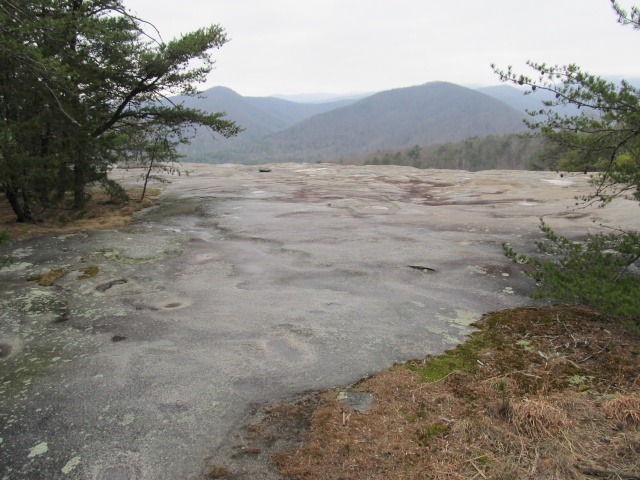
Stone Mountain takes its name from the broad expanse of an exposed granite dome that forms its summit. I was not actually on Stone Mountain, because I did not have the time to do the trail that takes one there. I was on a smaller, secondary mountain called Wolf Rock, that has a similar geology. I have come across such granite domes elsewhere in my travels about the Southern Appalachians, but I had never been to one as big as this, and this one is only a fraction of the size that Stone Mountain is:

The distance view from this little mountain top was not too bad:
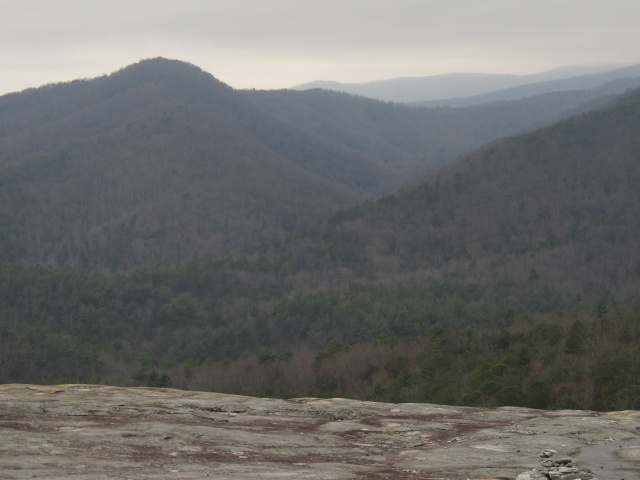
But the near view was even more compelling. It is a strange environment, dominated by stone, stark and open, and everywhere you look is some intriguing detail to catch the eye:


Up on these granite domes there are thin pockets of gravelly soil, where can be found growing gnarly old trees, the hardiest of tough survivors. All of the trees I saw in this area were Redcedars and Virginia Pines (Pinus virginiana), both species being able to resist drought and eke out a living where most other trees would wither and fail. Here is a Redcedar that stood maybe 7ft (2.1m) in height and was equally wide:

Here, a group of Virgina Pines:

An interesting configuration of trunks on 2 pines growing side by side:

Another group of pines, and one bound to draw the attention of a bonsai enthusiast:

Here is a closeup of that tree at the foot of the grouping:

I suspect this tree would be very easily collected, as its roots appeared to be in a shallow pocket and not down into a crevice. There were many "collectable" trees up here, and it is my most sincere wish that none of them will ever be collected! To start with, this is public land, a park, a shared space that exists for everyone to enjoy. Permission would never be given to collect such specimens here, so to do so would be illegal, not to mention greedy and ethically wrong. Beyond that, such trees are relatively rare in the eastern US and they are part of the experience of being in one of these special environments. I was able to enjoy viewing these trees on the day I was there only because all those who were there before me left them untouched. This is a subject of some contention among bonsai enthusiasts, and I realize there are places where collecting old, gnarly, naturally dwarfed trees is not only permitted but can be reasonably justified. Not so in this situation. I was thrilled to find this spot, and see these trees, and I hope people yet unborn will visit one day and be able to have the same experience.
There was one such tree I particularly enjoyed. It, too, was a Virginia Pine and stood about 6ft (1.8m) or so in height, but it stood out because it was all by itself:

Here is a detail of the base of the tree, growing in the space between 2 large, flat stones:

A view from a slightly different angle, that I would offer as the "official portrait" of this specimen:

Although I was watching my time walking up the mountain, when I got on top of it I somehow lost track. I thus found myself in an all too familiar situation - having 2 hours in which to make a 2 and 1/2 hour drive, and being nowhere near my vehicle. I had to run down the mountain and could not stop to take any more pictures. It was easy to forget about time up there. The whole while I was at the park, the only other human I saw was the woman working at the visitor center. Once I was on the trail I had the whole mountain to myself, just me and the trees and the sky.
There is a quote from a text long ago declared heretical by the Church, attributed to Jesus, and it says this: "The kingdom of the Lord is spread out upon the earth, and men do not see it." Sometimes, if you are in the right place at the right time and in the right frame of mind, I think you can see it plainly enough.
Which segues nicely into today's post, which is more or less a photo essay.
Spring, in addition to being the time when there is so much to do with the bonsai in the collection and the plants in the garden landscape, is also a highly active time of year for presenting bonsai educational programing for clubs and conventions. A couple of weeks ago I went to Roanoke, VA for just that purpose, and made an interesting side trip. I have been presenting programs to the Hinoki Bonsai Society in Roanoke on an annual basis for the past dozen years, and I think on every one of those trips I have made a point of venturing away from the direct Interstate route and taking the opportunity to do some back country exploring. There is an abundance of beautiful, Southern Appalachian scenery between Asheville and Roanoke! This year I set my sights on visiting one of North Carolina's State Parks - Stone Mountain - where I had never previously been:

Stone Mountain State Park is located in Wilkes and Allegheny Counties, a fairly rural section of North Carolina, not too far from the boarder with Virginia. The Blue Ridge Parkway skirts along its northern periphery. The park covers more than 14,100 acres, but I was on a very limited time schedule and was able to see only a tiny fraction of it. I picked out a short trail, 1.5 miles (2.4km), up to a small mountain top, and then the same trail back. As the trail started out, it passed through a nice stand of old White Pines (Pinus strobus), with a dense growth of Rosebay Rhododendron (Rhododendron maximum) for an understory, but it was a cloudy day and in the shade of the pines my camera was useless. As the elevation increased the pines gave way to hardwoods, and there were many oaks:

It is hard to tell, looking at the photographs, but these were some sizable, old trees. There was one Chestnut Oak (Quercus prinus) right near the trail that was particularly impressive. It was easily 4ft. (1.2m) in diameter at a height of 4ft. above ground, and had the characteristic rough, deeply fissured bark found on mature trees of this species:

It was impossible for me to get all of this tree in one shot, which is usually the case when trying to photograph big trees in the forest. Although it does not come even close to giving a proper sense of how impressive this specimen was, here is a look up into the looming canopy:

I hurried along with one eye on the clock, which is a terrible way to take a walk in the woods, and made the top of the mountain in a short while. There I came across this tree, an Eastern Redcedar (Juniperus virginiana) and I began to have the feeling I had picked a good trail:

What might appear in the photograph to be a sidewalk of some sort, of concrete or asphalt, is actually exposed granite. Here is a closeup of the section where the trunk of the tree makes a 90 degree angle:

Here is the same tree, seen from the opposite side:

When I come across trees such as this, I always wonder how they might work as bonsai. Not in the sense of lifting it off the mountain and planting it in a gigantic pot, but rather as a model for shaping a much smaller tree. This is an example, I think, of a tree form that many bonsai critics would find unacceptable, mostly because of its rigid lines and the sharp right angle.
Moving past this sentinel tree, along the granite "walkway", I headed toward some open sky in the near distance. I passed through a grove of old Redcedars, none more than 25ft (7.6m) in height:

The ground plane in this area was a world unto itself:

Moving on, the vista began to open:

Stone Mountain takes its name from the broad expanse of an exposed granite dome that forms its summit. I was not actually on Stone Mountain, because I did not have the time to do the trail that takes one there. I was on a smaller, secondary mountain called Wolf Rock, that has a similar geology. I have come across such granite domes elsewhere in my travels about the Southern Appalachians, but I had never been to one as big as this, and this one is only a fraction of the size that Stone Mountain is:

The distance view from this little mountain top was not too bad:

But the near view was even more compelling. It is a strange environment, dominated by stone, stark and open, and everywhere you look is some intriguing detail to catch the eye:


Up on these granite domes there are thin pockets of gravelly soil, where can be found growing gnarly old trees, the hardiest of tough survivors. All of the trees I saw in this area were Redcedars and Virginia Pines (Pinus virginiana), both species being able to resist drought and eke out a living where most other trees would wither and fail. Here is a Redcedar that stood maybe 7ft (2.1m) in height and was equally wide:

Here, a group of Virgina Pines:

An interesting configuration of trunks on 2 pines growing side by side:

Another group of pines, and one bound to draw the attention of a bonsai enthusiast:

Here is a closeup of that tree at the foot of the grouping:

I suspect this tree would be very easily collected, as its roots appeared to be in a shallow pocket and not down into a crevice. There were many "collectable" trees up here, and it is my most sincere wish that none of them will ever be collected! To start with, this is public land, a park, a shared space that exists for everyone to enjoy. Permission would never be given to collect such specimens here, so to do so would be illegal, not to mention greedy and ethically wrong. Beyond that, such trees are relatively rare in the eastern US and they are part of the experience of being in one of these special environments. I was able to enjoy viewing these trees on the day I was there only because all those who were there before me left them untouched. This is a subject of some contention among bonsai enthusiasts, and I realize there are places where collecting old, gnarly, naturally dwarfed trees is not only permitted but can be reasonably justified. Not so in this situation. I was thrilled to find this spot, and see these trees, and I hope people yet unborn will visit one day and be able to have the same experience.
There was one such tree I particularly enjoyed. It, too, was a Virginia Pine and stood about 6ft (1.8m) or so in height, but it stood out because it was all by itself:

Here is a detail of the base of the tree, growing in the space between 2 large, flat stones:

A view from a slightly different angle, that I would offer as the "official portrait" of this specimen:

Although I was watching my time walking up the mountain, when I got on top of it I somehow lost track. I thus found myself in an all too familiar situation - having 2 hours in which to make a 2 and 1/2 hour drive, and being nowhere near my vehicle. I had to run down the mountain and could not stop to take any more pictures. It was easy to forget about time up there. The whole while I was at the park, the only other human I saw was the woman working at the visitor center. Once I was on the trail I had the whole mountain to myself, just me and the trees and the sky.
There is a quote from a text long ago declared heretical by the Church, attributed to Jesus, and it says this: "The kingdom of the Lord is spread out upon the earth, and men do not see it." Sometimes, if you are in the right place at the right time and in the right frame of mind, I think you can see it plainly enough.

Arthur Joura- Member
 Re: American Bonsai at the NC Arboretum
Re: American Bonsai at the NC Arboretum
I love this last post Arthur!!!! And may I say that I read all your posts carefully and I've yet to detect a misspelling. Excellent grammar!!!! A compliment from a non-American 
Thanks for keeping up with this thread!!!
Sam
Thanks for keeping up with this thread!!!
Sam

Sam Ogranaja- Member
Page 9 of 40 •  1 ... 6 ... 8, 9, 10 ... 24 ... 40
1 ... 6 ... 8, 9, 10 ... 24 ... 40 
 Similar topics
Similar topics» American Bonsai at the NC Arboretum
» WISTERIA BONSAI AT INTERNATIONAL BONSAI ARBORETUM
» Ashville arboretum bonsai
» Carolina Bonsai Expo @ NC Arboretum
» Autumn at the NC Arboretum bonsai garden
» WISTERIA BONSAI AT INTERNATIONAL BONSAI ARBORETUM
» Ashville arboretum bonsai
» Carolina Bonsai Expo @ NC Arboretum
» Autumn at the NC Arboretum bonsai garden
Page 9 of 40
Permissions in this forum:
You cannot reply to topics in this forum








